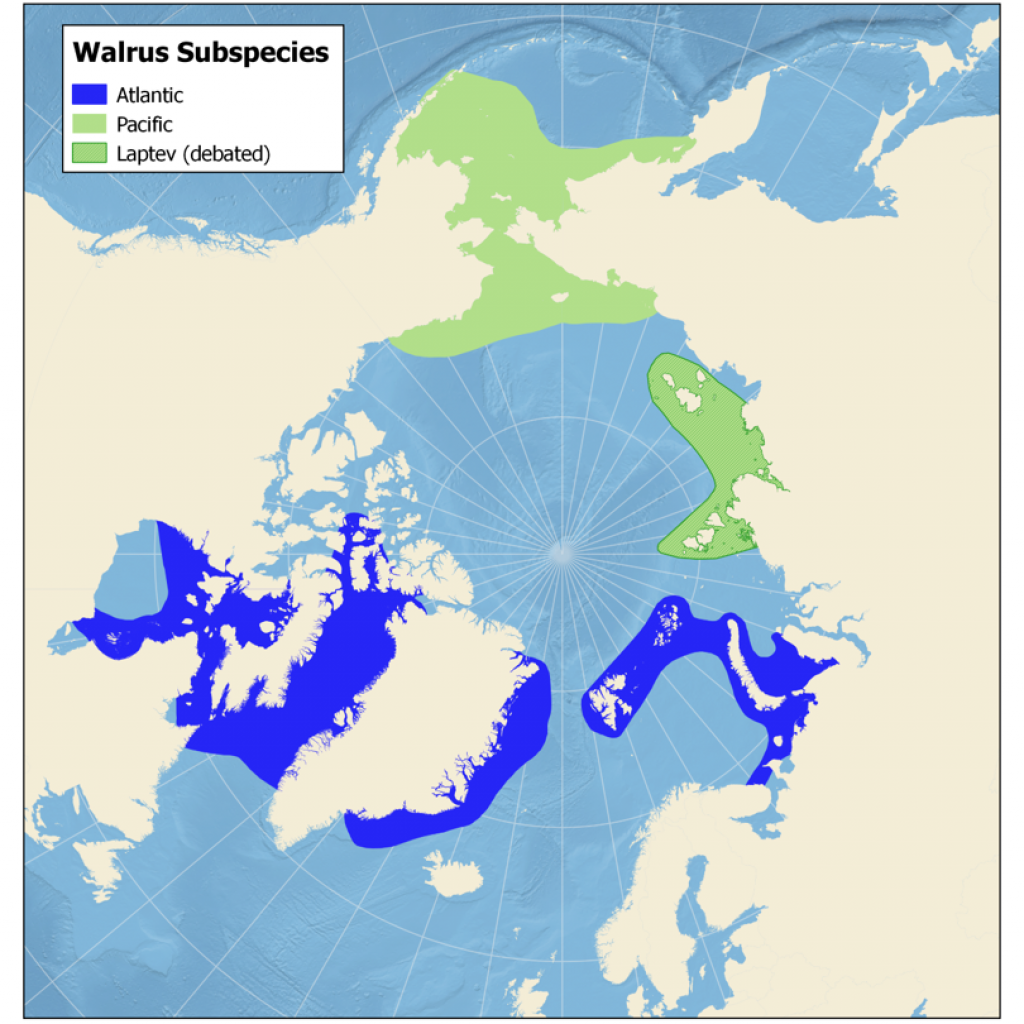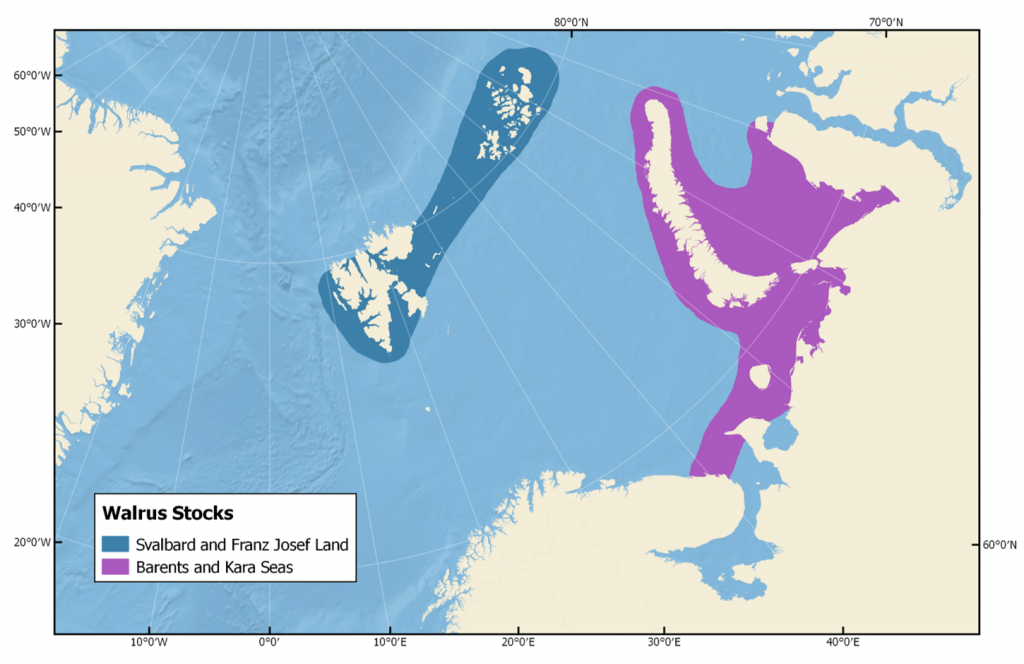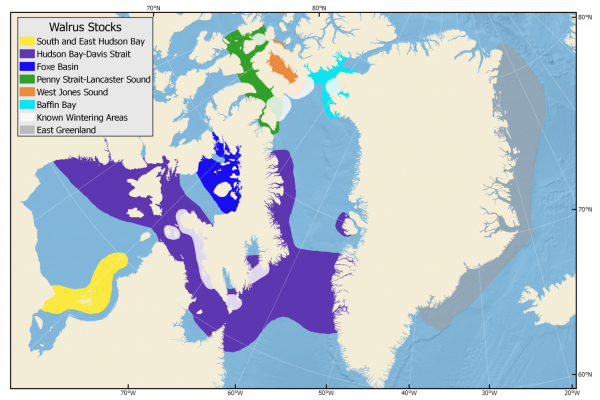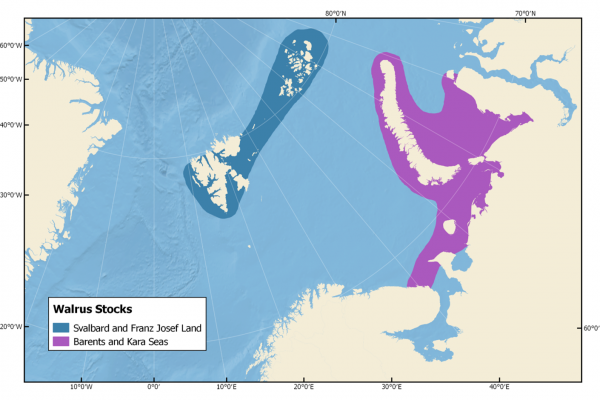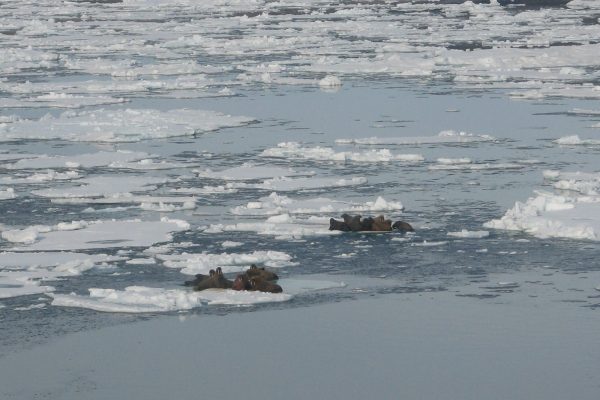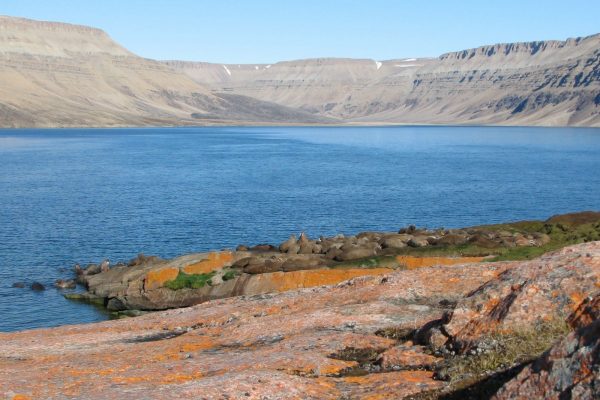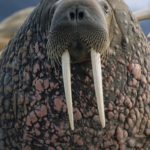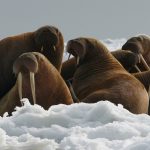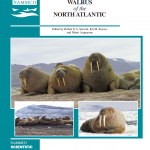Atlantic Walrus
Updated: January 2021
The walrus is one of the largest Pinnipeds (the group that contains all types of seals and walrus) and is the largest member of this group to live in the Arctic. In Atlantic walrus, males weigh around 1200 to 1500 kg and reach lengths of close to 3 m. Females are smaller, weighing around 600–700 kg and reaching lengths of 2.5 m. Walrus are a cinnamon-brown colour overall, and are characterised by their moustache and long tusks. They are a social animal that can be found in groups from several individuals to several hundred animals.
Abundance
There are several stocks of Atlantic walrus with the largest of them occuring in Arctic Canada and West Greenland. In the North Atlantic, walrus number around 30,000 animals.
Distribution
Atlantic walrus are found in Arctic waters in areas that are seasonally ice-covered. They are found in the northern waters of Canada, Greenland, Norway and Russia.
Relation to Humans
Indigenous communities hunt walrus for food, leather and tusks in Canada and Greenland. Populations were reduced in the past by commercial hunting in all areas, and populations were depleted in some areas (e.g. Iceland).
Conservation and Management
Management in Greenland is conducted by the Government of Greenland, with scientific and management advice received from NAMMCO. Walrus are protected in Svalbard and mainland Norway.
The Atlantic walrus is listed as ‘Near Threatened’ on the global IUCN Red List (Lowry 2016). It is listed as ‘Vulnerable’ on the Norwegian and Greenlandic red lists.
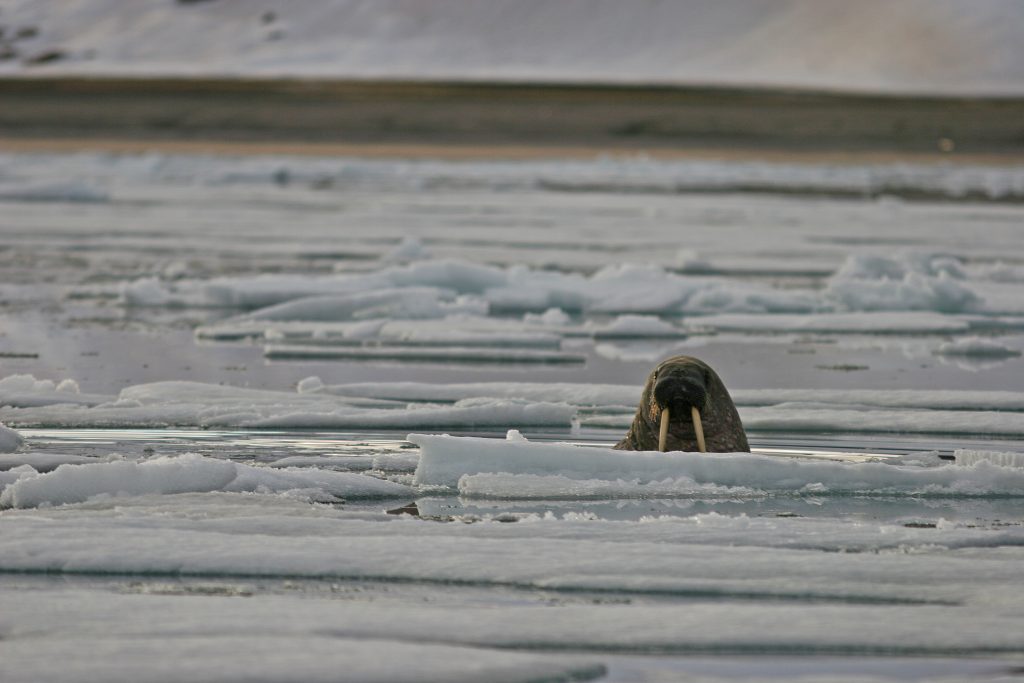

© K. Kovacs and C. Lydersen / Norwegian Polar Institute
Scientific name: Odobenus rosmarus rosmarus
Faroese: Roysningur
Greenlandic: Aaveq
Icelandic: Rostungur
Norwegian: Hvalross
English: Atlantic walrus
Danish: Hvalros
The origin of the name “walrus” is uncertain, but it may be derived from the Old Norse word hrossval, meaning “horse-whale”.
Lifespan
Up to 40 years.
Productivity
One calf every 2-3 years from 5-12 years of age.
Feeding
Walrus mainly feed on bivalve molluscs (clams) and other benthic (sea bottom) invertebrates. Some walrus, particularly large males, hunt and kill seals (ringed and bearded seals mostly, but also young walrus), seabirds and even narwhals and belugas (COSEWIC 2017).
Size
Male Atlantic walrus reach weights of 1,200 to 1,500 kg and lengths of close to 3 m. Females are smaller than males, weighing up to around 600 – 700 kg and reaching lengths of 2.5 m.
General Characteristics
Throughout their range, walrus inhabit cold Arctic and subarctic waters. In winter they live amongst pack ice, in leads and polynyas (open water areas within the ice) and occupy coastal areas with access to shallow water during the summer. During the open water season, they will tend to have a larger home range.
Walrus are a cinnamon-brown colour overall the young being deep brown and growing paler and more cinnamon-coloured, with older males becoming nearly pink. They are characterised by their moustache and long tusks. These elongated canines are present in both male and female and can reach a length of 1 m and weigh up to several kilos. Tusks are slightly longer and thicker among males, which use them for fighting, dominance and display; the strongest males with the largest tusks typically dominate social groups. They are also used to aid the walrus in climbing out of water onto ice and to form and maintain holes in the ice. Walrus can protrude their eyes and see in both a frontal and dorsal direction, because of the development of the extraocular muscles and the lack orbital roof.
Males reach weights of around of 1200-1500 kg and lengths of close to 3 m. Females are smaller, they weigh up to around 600–700 kg and reach a length of 2.5 m (Born et al. 1995).
Walrus generally have relatively few teeth other than the tusks. A broad mat of stiff bristles, up to 700 and reaching up to 30 cm, surrounds the tusks, giving the walrus its characteristic whiskered appearance. Walrus are sparsely covered with fur and nearly bald. Its characteristic skin is highly wrinkled and thick, up to 10 cm around the neck and shoulders of males. The blubber layer beneath is up to 15 cm, providing high isolation and energy reserve. Males also acquire significant nodules, called “bosses”, particularly around the neck and shoulders.
Extremely social animals, walrus can be found in groups from a few individuals to several thousand animals. When hauled out on land, they prefer to maintain body contact with one another and form very compact groups.
Subspecies and congeneric species
The walrus is the only living species in the Odobenid family (Odobenidae), which includes one genus with a single species and two subspecies, the Atlantic walrus (O. rosmarus rosmarus), the Pacific walrus (O. rosmarus divergens). There is also possibly a third subspecies off the North coast of Asia particulalry in the Laptev Sea (O. rosmarus laptevi). The three subspecies are geographically isolated. Walrus found in the Laptev Sea are more closely related to the Pacific than the Atlantic walrus (Lindqvist et al. 2008).
The Atlantic walrus is the slightly smaller of the two recognised subspecies. A male Pacific walrus can weigh up to 1700 kg and be nearly 4 m long. The Atlantic walrus also tends to have relatively shorter tusks and somewhat more flattened snout.
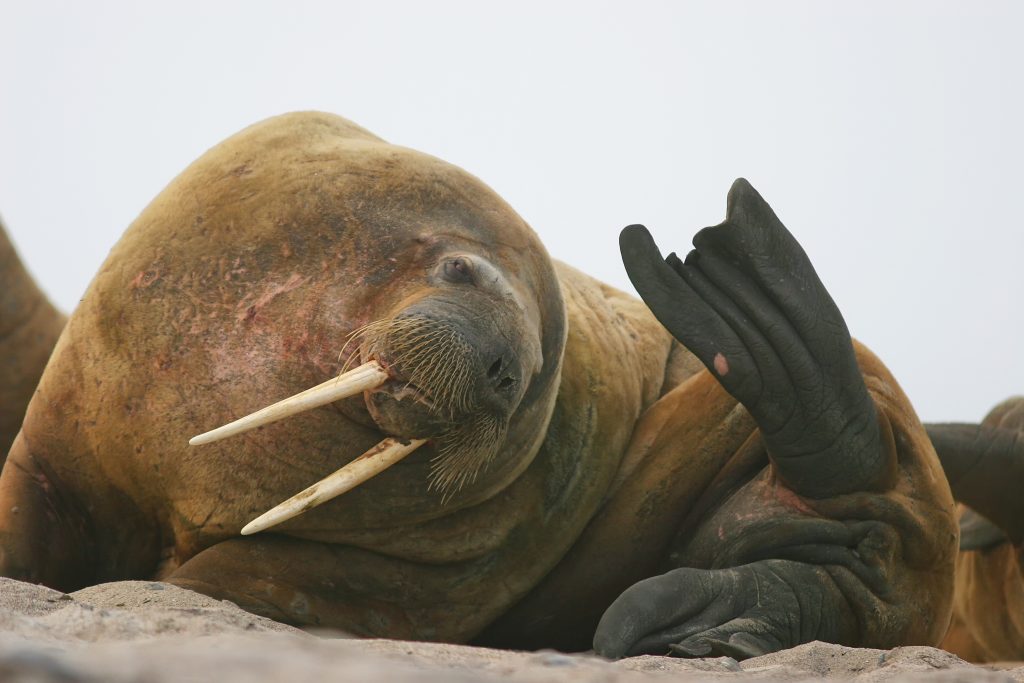
© Fernando Ugarte
Behaviour
In one study in northeast Greenland, one walrus was fitted with a satellite tag to record its foraging and diving activity. During a 74-hour period of foraging at sea, the walrus spent 57% of its time diving to depths of between 6 and 32 m, and made a total of 412 dives, each lasting between 5 and 7 minutes. It was estimated that this walrus ingested 57 kg (95% CI: 41–72 kg) wet weight bivalve biomass per day, or close to 5% of his total body mass. An average of 53.2 bivalves were consumed per dive, corresponding to 149.0 g shell-free dry weight, or 2,576 kJ per dive (Born et al. 2003).
Walrus seem to be fairly consistent across their geographic range in spending about 25% of their time hauled out, at least during late summer (Lydersen et al. 2008). Diurnal variation in haulout patterns has also been observed, with a tendency for walrus to haulout during the afternoon and evening (Stewart et al. 2013).
Social behaviour
Walrus are social animals and can be found in groups from a few individuals to several thousand animals, depending on the time of year and the particular population being observed. When hauled out on land, walrus prefer to maintain body contact with one another, and tend to form a group which is roughly circular (Salter 1979). New additions to the group will walk around the periphery trying to find their spot or attempt to displace other animals (Salter 1979). Tusk displays and jabbing are particularly often seen in walrus hauled out on land, although walrus with comparatively short tusks struck much less frequently than did walrus with longer tusks (Salter 1979).
Vocalisations
Walrus are also very vocal animals capable of producing a wide variety of sounds. Males especially produce long and repetitive vocalisations of various types, with bouts of “singing” that can last up to 65 hours (Sjare et al. 2003). One type of sound produced is short, sharp pulses, termed taps and knocks. The rate at which they are given can vary from 1 to 15 per second (Stirling et al. 1983). Taps and knocks are given in at least four different patterns: double knock, tapping or knocking sequence, coda, and diving vocalisation (Stirling et al. 1983).
The double knock is a distinctive call given by some males before surfacing to breathe during a stereotyped vocalisation cycle. In the long tapping or knocking sequences, pulses are usually given at a rate of about 1 to 3 per second. The sequences start slowly in some cases but quickly in others. The last few taps or knocks are often given in a rapid burst, termed the “coda”, sometimes followed by a bell call. During stereotyped vocalizing cycles, the male always gives a distinct call, which was termed the diving vocalisation, immediately after taking his last breath and descending from the surface (Stirling et al. 1983).
Breeding behaviour
Vocalisations are an important part of the breeding behaviour of walrus. Breeding takes place in the winter, from January to mid-April, in polynyas (open water areas within the ice) or areas of unconsolidated pack ice. The mating system of walrus is best described as “female defence polygyny” (Sjare and Stirling 1996). A large mature male walrus, probably at least 15 years old, will “attend” or monopolise access to herds containing potentially reproductive females for extended periods of time, chasing away other males that approach. Any females that come into estrus during that time will mate with the attending male.
Vocalisations appear to mediate at least some interactions between males during the breeding season. When attending a herd of females, a single male may continuously repeat a complex, stereotyped song (Sjare and Stirling 1996). It is thought that these vocalisations convey his social status. Other sexually mature males in the area behave as silent herd members, vocal satellite males, or sometimes both. In some cases, males become silent and move out of the area when a singing attending male approaches them (Sjare and Stirling 1996). Sometimes these interactions escalate into fighting: if a young adult male approaches a female closely or vocalises, the attending male will attack and chase him away (Sjare and Stirling 1996).
Reproduction
Walrus are long-lived animals with a low reproductive rate. A walrus can live to be 40 years old. Females reach sexual maturity between 4-10 years of age, males at 6-10 years, although males likely cannot compete successfully for females until they are around 15 years of age. Mating takes place in the water and occurs in areas of drifting pack ice or polynyas during the winter, usually from January to April (Sjare and Stirling 1996). The implantation of the embryo is delayed for 3 or 4 months, after which the gestation period is 12 months (Richard 2001). The pregnancy therefore lasts 15 or 16 months, meaning that females can only give birth a maximum of once every two years, although it is more commonly 3 years between calves. The result is that the walrus pregnancy rate is much lower than that of other pinnipeds (seals).
Walrus calves are born on land or on the pack ice between late April and early June. The calf is nursed solely on milk for the first 6 months or so, before beginning to eat solid foods. Nursing mostly takes place in the water but can also sometimes on land or ice. The nursing period typically lasts for 2 years, with weaning occurring gradually over a period of time.
Feeding
Walrus are primarily bottom feeders, foraging in sediments on the ocean floor for bivalve molluscs (clams) and other invertebrates (Outridge et al. 2003). The soft parts of clams, the feet and siphons, have been found to make up 95% of the weight of walrus food intake. The main species taken in Greenland are the bivalves Mya truncata, Serripes groenlandicus, Hiatella arctica and Macoma baltica (Dietz et al. 2014). A study of the fatty acid composition of walrus inner blubber from Svalbard found that its composition closely resembled the fatty acid composition of the lipids in the bivalves Mya truncata and Buccinum spp. (Lydersen and Kovacs 2014). Other invertebrates are eaten to varying extents and fish may also be taken although this is rare (Born et al. 1995).
Feeding behaviour
Walrus need to eat a large amount of clams to meet their energy needs. One study in northeast Greenland was able to quantify the amounts of food eaten by walrus using a combination of diver observations and satellite-telemetry data on movement and diving activity (Born et al. 2003). On 10 occasions, divers were able to observe walrus feeding and collect empty bivalve shells from the sea floor. An average of 53.2 bivalves were consumed per dive, corresponding to 149.0 g shell-free dry weight, or 2,576 kJ per dive (Born et al. 2003).
In the same study, one walrus was fitted with a satellite tag to record its foraging and diving activity. During a 74 hour period of foraging at sea, the walrus spent 57% of its time diving to depths of between 6 and 32 m, and made a total of 412 dives, each lasting between 5 and 7 minutes. It was estimated that this walrus ingested 57 kg (95% CI: 41–72 kg) wet weight bivalve biomass per day, or close to 5% of his total body mass (Born et al. 2003).
Also mammals and birds
Although they are primarily benthic (bottom) feeders, some walrus also eat seals and other large animals. Such predation seems to be largely carried out by older males. Ringed seal, bearded seal, as well as beluga and narwhal remains have all been found in adult walrus stomachs (Richard 2001). Walrus have also been documented hunting various species of birds. In Svalbard, walrus were observed hunting flightless pinkfooted geese (Anser brachyrhynchus) as well as bearded and ringed seals (Lydersen and Kovacs 2014).
Predators
Apart from humans, the main predators of walrus are killer whales (Orcinus orca) and polar bears (Ursus maritimus). It is mainly calves and younger walrus that are susceptible to such predation.
DISTRIBUTION
Walrus are found in all Arctic waters in areas that are seasonally ice-covered in both the Atlantic (Atlantic walrus, O. rosmarus rosmarus) and the Pacific (Pacific walrus, O. rosmarus divergens), as well as off the North coast of Asia, particularly in the Laptev Sea (Laptev walrus, O. rosmarus laptevi), creating three subspecies that are geographically isolated.
Atlantic walrus are found in the northern waters of Canada, Greenland, Norway and Russia.
Habitat
Walrus occupy a large range but have a narrow ecological niche, requiring large areas of shallow water with bottom substrates that support a productive bivalve community and the reliable presence of open water over feeding areas, as well as suitable ice or land nearby for haulout (e.g., Kovacs 2016, COSEWIC 2017). Habitat use by walrus varies according to the season. For most of the year, walrus are widely dispersed over vast areas where they usually occur in clumped groups (Heide-Jørgensen et al. 2013). In spring and summer, walrus are generally found in coastal areas throughout their distribution, where water depths are relatively shallow and they can access their favoured benthic foods. Summer habitat use is also driven by available haulout areas (Freitas 2009). Proximity to human settlements is also a factor in habitat choice, as walrus that are disturbed or displaced from an area tend not to return.
Haul out sites
Walrus prefer hauling out on sea ice when they can, rather than on land (Lydersen et al. 2008). In the summer when ice is not available, groups of walrus haul out onto land at traditional sites, called uglit in Inuktitut. These are often located close to their feeding grounds, although walrus have been observed travelling up to 100 km from these sites to feed (Witting and Born 2005). Some sites may be used year after year, while others are more transient. There is considerable variation in site use by walrus both within and between years (Stewart et al. 2013c). In 2018, a walrus was observed at 89° 38.2′ N, 24° 4′ E, which is the most northern sighting of a walrus in observational records so far (Lydersen 2022). It was most likely a vagrant visitor to this area and its trip to this extreme latitude can be considered exploratory.
Walrus seem to be fairly consistent across their geographic range in spending about 25% of their time hauled out, at least during late summer (Lydersen et al. 2008). Diurnal variation in haul-out patterns has also been observed, with a tendency for walrus to haul out during the afternoon and evening (Stewart et al. 2013a).
Sea ice
Sea ice is important habitat for walrus. In several studies, the preferred percentage of ice for walrus in West Greenland was 50-60% cover, with some variation according to sex, season and year (Dietz et al. 2014, Born et al. 1995). In the Svalbard-Franz Josef Land region, some walrus winter in very dense pack ice (Lydersen and Kovacs 2014, Freitas et al. 2009). Walrus are unable to break through ice that is thicker than about 20 cm (Fay 1982) but in both West Greenland and SE Baffin Island, shallow polynya and pack-ice areas with dynamic leads exist where walrus can overwinter.
Satellite tagging has shed light on the movements and habitat use of walrus and the relative importance of foraging areas both in the Pacific and Atlantic walrus (Crawford et al. 2016, Citta et al. 2018, NAMMCO 2018).
Greenland
Off western Greenland, areas of preferred habitat are offshore banks (<200 m deep) with suitable food items. One such area is west of Disko Island (69.75° to 70.75° N) while another is Store Hellefiske Banke (66.50° to 68.25° N) in the Sisimiut-Aasiaat area (Andersen et al. 2014). Store Hellefisk Banke has water depths ranging from 20 to 200 m and is frequented by walrus during spring (Dietz et al. 2014). These two shallow areas are separated by the entrance to Disko Bay where water depths exceed 200 m and where walrus are generally not found (Heide-Jørgensen et al. 2013).
Walrus spend from fall to spring in these two areas, but are absent from them in summer. Once the sea ice has melted, walrus will migrate the roughly 450 km across Davis Strait towards SE Baffin Island (Andersen et al. 2014, Heide-Jørgensen et al. 2103).
Variation by Sex and Season
As well as varying by season, habitat use varies by sex. Males have larger home ranges than females and tend to occur farther offshore, farther from the ice edge and at greater depths than females. Frietas et al. (2009) documented quite regular annual movement patterns for 17 male walrus around Svalbard. During summer, walrus were most often found in coastal areas with a median distance to the coast of 4.6 km. In the winter, most of the tagged males performed long distance movements, up to 840 km from the tagging locations, and returned sometime between late February and late June.
Summer
The choice of summer haulout sites also appears to differ between males and females. Adult females with calves occur more frequently at sheltered inshore haulout sites whereas the off-shore exposed rocks facing deeper waters have a higher proportion of adult males (Dietz et al. 2014).
Similar results were seen in a more recent tagging study of adult male walrus from Svalbard. During the winter, they moved into areas of >90% ice concentration, traveling as far as 600 km from ice-free water (Lydersen and Kovacs 2014). It is thought that these males moved into their breeding areas in the winter, based on the timing of the occupancy and diving behaviour in that area. When the breeding season was over, walrus with satellite tags that were still transmitting locations returned to the Svalbard coast, showing high site fidelity to the previous year’s summering area (Lydersen and Kovacs 2014).
Winter
Winter habitat use, especially for males, seems to be driven by breeding needs and appears to be independent of water depth and distance to shore (Frietas 2009). Males seem to feed little during the breeding season and their habitat selection is probably mainly affected by the presence of females. (Lydersen and Kovacs 2014, Frietas 2009).
Other areas
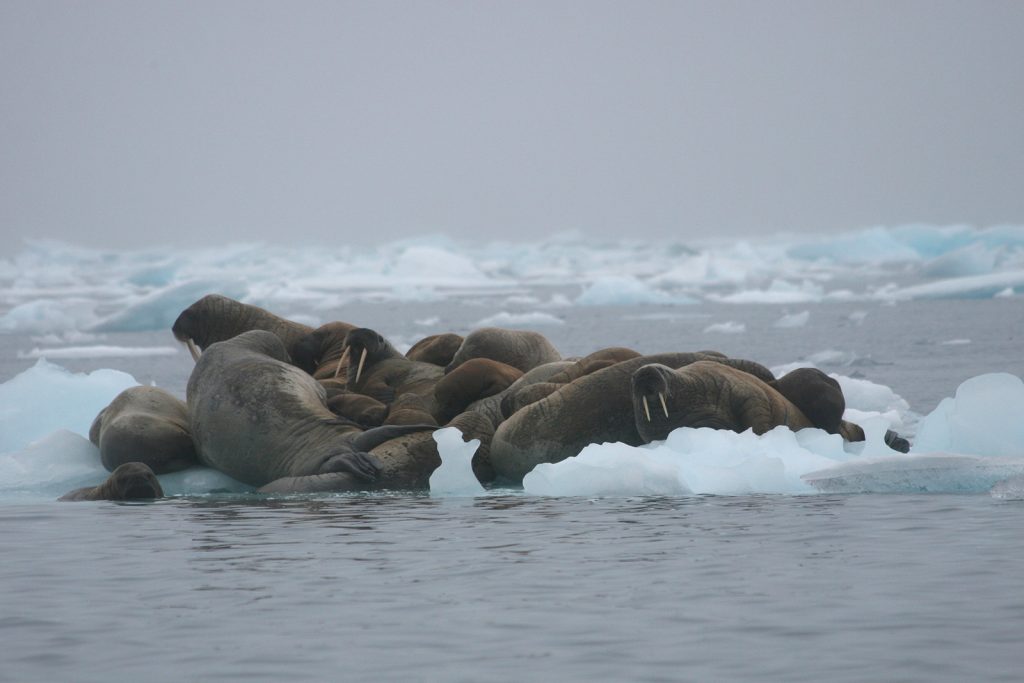
Walrus © R. Stewart
Differences between male and female habitat use is also seen in other areas. Along Southeastern Baffin Island in the fall, dispersal of walrus along the coast tends to be more condensed, with greater segregation seen between males and females. Females tend to remain farther north and farther east, and males are more often located offshore in areas with greater water depths. Males also demonstrated larger home ranges than females during both seasons (Dietz et al. 2014). Females and calves seem to prefer to remain in association with drifting ice as much as is possible, but they are also found in coastal areas in summer throughout the range of the species (Freitas et al. 2009). Another consideration for females that will influence their habitat choices is their need to feed throughout the year, including times when they are pregnant or nurturing young.
North Atlantic Stocks
The delineation of walrus stocks in the North Atlantic (and the names used to refer to them) have changed over the years as new research has become available. A summary of key steps in the evolution of walrus stock definitions is provided below, with more detail on the delineations provided by country in latter sections.
Historical development
In 1995, Born and colleagues proposed 8 different stocks across Canada, Greenland, Norway and the Russian Federation, with management regimes, history of exploitation, distribution and reproductive isolation through geographic separation as underlying considerations (Born et al. 1995). These initial 8 stocks were named: 1. Foxe Basin, 2. Southern and Eastern Hudson Bay, 3. Northern Hudson Bay-Hudson Strait-Southeast Baffin Island-Northern Labrador, 4. Western Greenland, 5. North Water (Baffin Bay-Eastern Canadian Arctic), 6. Eastern Greenland, 7. Svalbard-Franz Joseph Land, 8. Kara Sea-Southern Barents Sea-Novaya Zemlya.
Later, research on the stocks in Canada using satellite-linked radio tags and analyses of genetics and chemical markers (stable isotapes), indicated that it may be useful to subdivide the North Water (Baffin Bay-Eastern Canadian Arctic) stock into three different stocks, and the Foxe Basin stock into two (Stewart 2008). In presenting this research, Stewart (2008) also proposed simplifying some of the stock names initially used by Born and colleagues. The proposed new names for the Canadian stocks, including the new subdivisions, were then: 1. North Foxe Basin, 2. Central Foxe Basin, 3. Southern and Eastern Hudson Bay, 4. Hudson Bay-Davis Strait, 5. Baffin Bay, 6. West Jones Sound, 7. Penny Strait-Lancaster Sound. Stewart (2008) noted that these proposed delineations created testable hypotheses and therefore the stocks could change again as research continued to be conducted.
In 2014, new genetic research suggested that there was a clear genetic division between two large clusters. This was referred to as the “high Arctic population” (containing the Baffin Bay, Penny-Strait-Lancaster Sound, and West Jones Sound stocks) and the “central Arctic population” (including the North Foxe Basin, Central Foxe Basin and Hudson Bay-Davis Strait stocks) (Shafer et al. 2014). This research also noted that within the high Arctic population, there was some evidence to support maintaining West Jones Sound as a separate stock but to combine the the Baffin Bay and Penny Strait-Lancaster Sound stocks.
The extension of the Hudson Bay-Davis Strait stock to West Greenland was documented through satellite tagging data (Dietz et al. 2014) and genetic analyses confirmed that walrus from the West Greenland stock were not genetically different from walrus at South East Baffin Island (Andersen et al. 2014). On the basis of this research it was agreed that these walrus should be regarded as belonging to the same stock for management purposes, and are now referred to as the West Greenland-South East Baffin Island component of the Hudson Bay-Davis Strait stock.
In 2017, research using satellite linked transmitters indicated an overlap in range between all three of the previously proposed stocks in the high Arctic population. This suggested that walrus occupying Smith, Jones and Lancaster Sounds in summer are potentially susceptible to hunting in Northwest Greenland and therefore that without further counter evidence to suggest discrete sub-stocks, a precautionary approach would be to manage the high Arctic population as a single stock (Heide-Jørgensen et al. 2020). This is currently referred to as the Baffin Bay stock.
Current stocks
For management purposes, NAMMCO currently recognises 3 stocks of walrus in Greenland (2 shared with Canada), 5 stocks in Canada (2 shared with Greenland), and 2 in the eastern North Atlantic.
| Area | Stock | Management Authority | Further details |
|---|---|---|---|
| High Arctic | Baffin Bay | Canada & Greenland | Includes previous subdivisions of Baffin Bay, West Jones Sound and Penny Strait-Lancaster Sound |
| Central Arctic | Central Foxe Basin | Canada | |
| North Foxe Basin | Canada | ||
| Southern & Eastern Hudson Bay | Canada | ||
| Hudson Bay-Davis Strait | Canada & Greenland | In Greenland referred to as West Greenland-Southeast Baffin Island | |
| Greenland Sea | East Greenland | Greenland | |
| Barents Sea | Northern Barents Sea | Norway & Russia | Norway: Svalbard Russia: Franz Josef |
| Southern Barents Sea | Russia | Includes Kara Sea, Novaya Zemlya and Pechora Sea |
Canada
Historically, walrus occupied Canadian waters on the east coast from Nova Scotia to perhaps 85°N and from the boundary with Greenland to roughly 100°W. However their range now is smaller and their distribution more discontinuous. Since 2018, the North Atlantic Marine Mammal Commission (NAMMCO) officially recognises two larger “genetic populations” and five walrus stocks in Canada. The high Arctic population is recognised as the Baffin Bay (BB) stock, which currently includes the previous subdivisions of the West Jones Sound (WJS), and Penny Strait-Lancaster Sound (PS-LS) stocks. The central Arctic population, includes the North and Central Foxe Basin (N-FB, C-FB) and Hudson Bay-Davis Strait (HB-DS) stocks (see map) (Stewart 2008, NAMMCO 2018). The relationship between these stocks and the Southern & Eastern Hudson Bay (S&E-HB) stock is unclear (DFO 2013).
Differentiation
The Baffin Bay stock was previously separated on the basis of seasonal distribution, tag tracking data, and limited isotope analysis (Stewart 2008). However, recent satellite tracking studies did not support delineation (Heide-Jørgensen et al. 2017). Even though this tracking data does not disprove the earlier research documenting genetic differentiation of the West Jones Sound stock (Shafer et al. 2014), it remains unclear whether walrus from Greenland tracked to West Jones Sound remain through the breeding season or return to Greenland in the winter (Heide-Jørgensen et al. 2017). It was therefore deemed more precautionary to manage walrus of the Canadian high Arctic and Northwest Greenland as a single management unit (NAMMCO 2018).
The two stocks in Foxe Basin are distinguished from each other and from HB-DS on the basis of lead isotope and trace element profiles (Outridge and Stewart 1999, Outridge et al. 2003). Local Inuit also distinguish between two types of walrus in Foxe Basin on the basis of size, colour and distribution (DFO 2002). However, there is a lack of genetic differentiation between Foxe Basin and HB-DS stocks. There may be some male-mediated genetic exchange between FB and the HB-DS and SE-HB Bay stocks, which could indicate a single interbreeding population (Shafer et al. 2014).
In the summer, walrus from each of these stocks are found along the coasts in the area they are named for. In the winter, their distribution is more limited. Wintering areas for the high Arctic stocks are in the Cardigan Strait–Fram Sound area at the west end of Jones Sound, around Dundas Island, the floe edges of Jones and Lancaster sounds, and in the North Water polynya between approximately 69° and 77° N on the Greenland coast (Stewart 2008).
Further south, walrus from the HB-DS stock winter in Cumberland Sound and other areas around south Baffin Island (Stewart et al. 2013b), while some south Baffin walrus winter off West Greenland (Dietz et al. 2014). Walrus in Foxe Basin generally winter at the floe edge around Rowley Island (Stewart 2008).
Greenland
There are three stocks of Atlantic walrus occurring in Greenland: the Baffin Bay stock, the West Greenland-Southeast Baffin Island “component” of the Hudson Bay-Davis Strait stock, and the East Greenland stock (Wiig et al. 2014). The three stocks have been differentiated on the basis of genetics, distribution and migration patterns (Witting and Born 2014). Two of these stocks, the Baffin Bay and the West Greenland-Southeast Baffin Island component, are shared with Canada.
Baffin Bay
The Baffin Bay stock is found in the coastal waters of Northwest Greenland and the northern reaches of the Canadian Arctic Archipelago.
These walrus are, however, absent from coastal areas of Northwest Greenland during the open water season in August-September, as they spend the summer along the eastern and southern coast of Ellesmere Island (Canada) and in the Canadian High Arctic archipelago (Stewart et al. 2013a). A survey in the North Water in May of 2009 and 2010 found most of the walrus distributed roughly in a belt from Greenland across to Ellesmere Island in the southern part of the North Water over both shallow and deep (>500m) water. Only three sightings were made north of 77° N (Heide-Jorgensen et al. 2012).
A study analysing data from satellite transmitters from 50 walrus from Northwest Greenland deployed during May-June 2010-2013 and 2015 (Heide-Jørgensen et al. 2017) showed the animals departing the feeding banks along the Greenland coast in June – July and most of them moving to Canadian waters in western Smith Sound. The most frequently used summering grounds were along the coasts of Ellesmere Island. In addition, however, nine tracks of these tagged animals entered West Jones Sound and four entered the Penny Strait-Lancaster Sound area, crossing two putative stock boundaries and demonstrating that the walrus population that winters along the north western coast of Greenland is shared more widely in Canada than previously thought.
West Greenland-Southeast Baffin Island
The West Greenland stock of walrus occurs off the central coast of West Greenland at the edge of the pack ice from about 66° N to 70° N from fall to spring (Witting and Born 2005). Based on satellite tracking data, it is clear that walrus in West Greenland are part of the larger Hudson Bay-Davis Strait population that summers primarily around Baffin Island (Dietz et al. 2014). Based on abundance estimates of the wintering ground in West Greenland, it is estimated that approximately 1/3 of the population uses West Greenland as their wintering ground (Heide-Jørgensen et al. 2014).
East Greenland
Along the eastern coast of Greenland, walrus occur year-round and are mainly distributed inside the National Park of North and Northeast Greenland, north of the entrance to Scoresby Sound (about 71° N) (Witting and Born 2014). There is very limited exchange between the East Greenland walrus and neighbouring populations, such as the West Greenland, North Water, and the Svalbard-Franz Land populations (Witting and Born 2005).

Curious walrus © R. Stewart
Norway / Svalbard
Information on distribution and studies of movement and genetics have shown that there is a common stock of Atlantic walrus found in the Svalbard and the Franz Josef Land archipelagos, in which most of the males summer in Svalbard and most females and calves remain in north-eastern parts of Svalbard and the Franz Josef Land area (Wiig et al. 2014, Lydersen and Kovacs 2014, Freitas et al. 2009).
While there has been a single documented exchange of walrus from East Greenland to Svalbard (Born and Gjertz 1993), this is likely rare. Walrus from East Greenland and Svalbard-Franz Josef Land differ genetically and are distinct stocks (Wiig et al. 2014).
The relation between the Northern Barents Sea stock around Svalbard-Franz Josef Land and walrus found further east around Novaya Zemlya and in the Laptev, south-eastern Barents, Pechora and White Seas is uncertain but are managed as two seperate units.
Russia
As mentioned above, Atlantic walrus in Franz Josef Land (Russia) and Svalbard (Norway) belong to a single population (Freitas et al. 2009). Walrus are also found south and east of Franz Josef Land, around Novaya Semlya and into the southern Barents, Pechora and Kara Seas (Wiig et al. 2014, Glazov et al. 2013). In a recent survey of the Pechora Sea, male walrus were found hauled out at three sites: one on Vaygach Island and two sites on Matveyev Island (Lydersen et al. 2012). Since no females or calves were seen during the survey, the population must be using a larger area than that surveyed.
Walrus found further east in the Laptev Sea are more closely related to the Pacific walrus than the Atlantic (Lindqvist et al. 2008).
Counting walrus
Aerial surveys are most commonly used to estimate the abundance of walrus. However, walrus are definitely one of the most difficult species to survey, because of their clumped distribution throughout remote areas and their simultaneous occurrence on sea ice, land, and in the water at some times of the year. In addition, large annual variations in sea ice distribution and extent affects their distribution and makes survey planning challenging. Even the current population estimates carry a great deal of uncertainty.
When they are hauled out on land or ice floes, walrus tend to lie piled on top of one another, making it hard to see all individuals, or even to count them in a photograph (Stewart et al. 2013). If walrus are disturbed for some reason at their haulout shortly before the survey, a large number of animals can be dispersed and not counted. Since walrus also spend time in the water, correction factors must be applied to any count to correct for the proportion of the population unavailable to be counted during the survey. These factors are difficult to obtain simultaneously with the survey. Because of these difficulties, walrus abundance estimates therefore tend to be imprecise and probably underestimate the true stock size (negative bias) in most cases (Heide-Jørgensen et al. 2013).
Abundance surveys conducted in Canada and Greenland on shared stocks cannot be combined since the animals tend to spend the summers in Canada but may winter in either Canada or Greenland. Greenlandic surveys in Baffin Bay are also conducted during the winter while Canadian surveys are conducted in summer and combining them therefore risks counting the same animals twice. Furthermore, winter surveys in Greenland include only part of the population that is surveyed in Canada in the summer.
Recent Abundance Estimates: Atlantic Walrus
| Stock | Year | Estimate | 95% Confidence Intervals | Source |
|---|---|---|---|---|
| Penny Strait – Lancaster Sound | 2009 | 727 | 623–831 | DFO 2013a, Stewart et al. 2013d |
| West Jones Sound | 2008 | 503 | 473–534 | Stewart et al. 2013d |
| Baffin Bay // North Water Polynya | 2018 | 1,279 | 938–1,744 | NAMMCO 2018 |
| North and Central Foxe Basin | 2011 | 14,093 | (SE 6,7) | DFO 2016b |
| South and East Hudson Bay | 2014 | 200 | 70–570 | Hammill et al. 2016b |
| Hudson Bay – Davis Strait | 2014 | 7,100 | 2,500–20,400 | DFO 2016a |
| East Greenland // Northeast Water | 2009 | 599 | 357–875 | NAMMCO 2018 |
| 2017 | 279 | 226–345 | ||
| Svalbard-Franz-Josef Land // Svalbard | 2012 | 3,886 | 3,553–4,262 | Lydersen et al. 2014, MOSJ 2019 |
| 2018 | 5,503 | 5,031–6,036 | ||
| Barents and Kara Seas // Pechora Sea | 2011 | 3,943 | 3,605–4,325 | Lydersen et al. 2012 |
| Barents and Kara Seas // Kara Sea – Novaya Zemlya | 2013 | 1,355 | Direct count | Semyonova et al. 2015 |
The Atlantic walrus is listed as ‘Near Threatened’ on the global IUCN Red List (Kovacs 2016), with a number of mature individuals estimated to 12,500 in 2015. All walrus populations were overhunted historically; most are recovering following complete protection or quota-based hunting (e.g., Kovacs 2016). Most populations are in low thousands if not low hundreds, even for hunted segments and the status of several is not clear or known.
The greatest threat for walrus is climate change and its associated impacts on sea ice, which alter their habitat and expose them to increased anthropogenic activity and potential impacts of acidification on bivalves, their main prey (Kovacs 2016, COSEWIC 2017, USFW 2017, Belikov 2018, NAMMCO 2018).
Historical population size
The total population of Atlantic walrus prior to the European discovery of North America must have been at least in the hundreds of thousands and was found over a much larger range than is the case today. This population estimate is a rough guess based on recorded observations by early explorers and traders, as well as known records from commercial walrus hunting. Walrus have been exploited in all areas for centuries, first by Inuit and later by European whalers and sealers. Hunting of walrus continues to be an important part of Inuit culture today, in both Arctic Canada and Greenland.
Archaeological walrus remains determine past distribution of Atlantic walrus in Canada and Greenland. Walrus remains are more common during later Paleo-eskimo periods (2,500-1,000 BP) in “diet-related” contexts (Wiig et al. 2014). They are particularly abundant around 2,500-2,300 BP and 1,500-1,000 BP, but less so in between. Paleo-eskimos likely left the High Arctic between 2,300-1,500 BP, potentially due to climate cooling, which could have influenced walrus distribution.
Depletion
Hunting by humans is the main cause of depletion of walrus during historic times (Born et al. 1995). The Norse hunted walrus in the Barents Sea and Greenland from sometime in the late 9th until the 15th century. Commercial hunting of walrus began in the late 1800s, roughly around the time of the end of the whaling era and continued until the mid-20th century (Wiig et al. 2014). Walrus were hunted for their skins, blubber and ivory tusks. This hunt took a great toll on walrus populations, with the result that by the mid 20th century, the population of Atlantic walrus had been reduced in nearly all areas and its range had shrunk substantially. In Svalbard, walrus were nearly completely extirpated (Wiig et al. 2000). Large herds that once hauled out on island and mainland beaches in cold temperate and subtemperate latitudes, for example as far south as Sable Island off Nova Scotia, Canada, have been exterminated, and walrus today are confined solely to the Arctic.
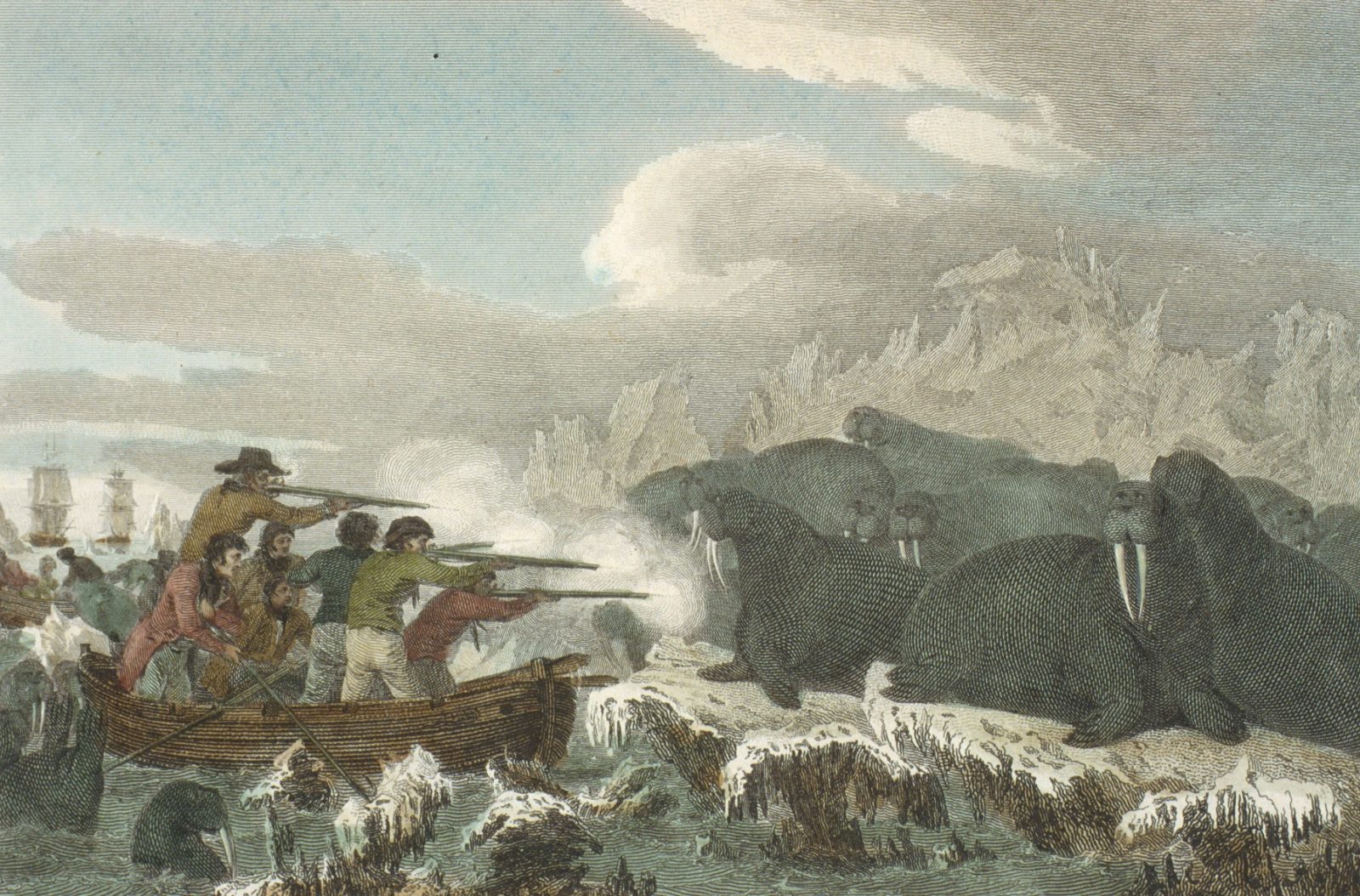
Canada
While walrus have been hunted by Inuit in the Canadian Arctic for centuries, it was only with the advent of commercial whaling in the late 1800s that walrus started to be heavily exploited in the high Arctic. Further south, in the Gulf of St. Lawrence, walrus were hunted to extirpation in the 1700s. Very high numbers of walrus were taken further north in the late 1890s and early 1900s, as many as 1,400 in one year. Between 1885 and 1913, whalers hunted at least 4,000 walrus from Baffin Bay and Davis Strait. In northern Hudson Bay and the Cumberland Sound area between 1831 and 1914, at least 4,750 walrus were taken (DFO 2013b). This unrestricted commercial hunt led to a serious decline in abundance in these stocks. The other result was a restriction of distribution to more northerly areas, whereas previously walrus were found as far south as the Gulf of St. Lawrence and Sable Island off Nova Scotia (Wiig et al. 2014). In 1928, regulations were introduced under the Fisheries Act banning the commercial hunting of walrus and limiting the hunt to Inuit communities (DFO 2013b).
It is difficult to say to what extent walrus populations have recovered since that time or what the population trends are, as there is little data available. As mentioned above, walrus are one of the most difficult animals to survey, and even the current population estimates carry a great deal of uncertainty.
Greenland
Great uncertainty exists about the numbers taken by European whalers and sealers from all three walrus stocks in Greenland, as hunts were not well documented. Prior to the 19th century, walrus were caught by the Greenlanders, the Norse from 985 until the latter half of 15th century, and European whalers and sealers from 17th century (Wiig et al. 2014 and references therein). Until about 1910, Scottish whalers caught walrus in the Baffin Bay region, including in West Greenland and the North Water areas. Norwegian sealers and whalers took walrus between about 1910 and 1923 offshore in West Greenland, and made large catches around the 1950s, presumably in northern Baffin Bay (Witting and Born 2005).
Although stock structure has been difficult to determine and there has been historical variation in the naming of stocks shared between Canada and West Greenland, in 2018, the NAMMCO Walrus Working Group agreed to operate with the following names for the Greenlandic stocks: Baffin Bay (a subunit of the former North Water population); West Greenland-Southeast Baffin Island (a ‘component’ of the larger Hudson Bay-Davis Strait population); and East Greenland (formerly Northeast Water).

Walrus on ice. © C. Lydersen
West Greenland-Southeast Baffin Island
This stock, which is shared by Canada and Greenland (and a component of the larger Hudson Bay-Davis Strait population), likely declined greatly between 1930 and 1960. Catches in Greenland peaked in 1938 with more than 600 animals taken, and more than 9,400 animals were taken in total over those three decades (Witting and Born 2014). The result was that the number of walrus in Central West Greenland was reduced by about 80% between 1900 and 1960. Catches were relatively low after this, and the population increased to 3,100 (95% CI: 2,500-4,400) by 1993 (Witting and Born 2014). Catches increased again at this time and the population experienced a minor decline between 1994 and the early 2000s.
In a precautionary assessment performed by the NAMMCO walrus working group in 2018 (NAMMCO 2018), population modelling with the latest data available indicated an increase in the population after quota for the hunt were introduced in 2007.
Baffin Bay
The Baffin Bay stock (earlier known as the North Water stock) was also subject to intense hunting during the late 19th and early 20th century, and by 2005 was estimated to have declined to a population of less than 10% of the 1900 level (Witting and Born 2005). As in other areas, the decrease caused by historical catches is unclear due to incomplete catch reporting prior to the 1950s. It is estimated that the population declined by 40% from the 1960s to 2005. Quotas were introduced in 2007. This led to a decline in the annual catches from about 150 from 1999 to 2003, to about 80 from 2004 to 2008 and the latest assessment of the population indicated a growing population (NAMMCO 2018).
East Greenland

© R. Stewart
The East Greenland population was also heavily exploited late in the 19th century and during the first half of the 20th century. As in other areas, catches were not well documented, but at least 268 walrus were taken in 1889, and at least 573 walrus were taken between 1898 and 1908. Since that time, hunts of this stock have been low, except for the period from 1925 to 1939 where a total of approximately 350 walrus were taken (Witting and Born 2014).
Based on an abundance estimate from 2009, population modelling suggested historical takes caused only small changes in the population, with a maximum depletion to 80% of the estimated original population in 1890 (Witting and Born 2014). Some management measures were introduced fairly early on for the protection of this stock. In 1938 and 1939, some restrictions were introduced on the hunting of walrus for Danish hunters and trappers, but not Norwegians, operating in North East Greenland north of about 73.30° N. These were introduced by the Danish hunting company “Nanok”. In 1951, a decree from the Danish Ministry of State Affairs gave complete protection to walrus north of 74.24° N in North East Greenland (Wiig et al. 2014).
Quotas were introduced for this stock in 2007 and in agreement with earlier assessments, the density-regulated population model used to conduct the assessment in 2018 estimates a stable or slightly increasing population that is close to carrying capacity (depletion ratio of 95%) (NAMMCO 2018).

© K. Kovacs and C. Lydersen / Norwegian Polar Institute
Norway
It is difficult to estimate the size of the original population prior to hunting, but the Northern Barents Sea stock around Svalbard/Franz Josef Land must have once been very large. The first recorded hunt of Atlantic walrus occurred in Svalbard in 1604 (Wiig et al. 2014), after which hunting continued for the next 200 years. By the middle of the 19th century the stock showed clear signs of decrease. The centuries of walrus hunting had brought the large herds in Svalbard to the verge of extinction. Because of this, all hunting was banned and walrus were given total protection in 1952 (Wiig et al. 2014).
Since that time, the population has been increasing slowly. A survey of all known terrestrial haul-out sites in Svalbard was carried out during August 2006. Overall, 2629 (95% CI: 2318–2998) walrus were estimated to be present in the Svalbard area during that period. A more recent survey of Svalbard was completed in 2012 and resulted in an estimate of 3886 (95% CI: 3553–4262) animals (Lydersen et al. 2014), which is a 48% increase from the 2006 survey (Kovacs et al. 2014). In addition to an increased abundance estimate, this survey also found more haul-out locations and more sites with mother-calf pairs.
Russia
The pre-hunt walrus population in the Northern Barents Sea (Svalbard-Franz Josef Land) stock was probably more than 30,000 but is only around 5,000 animals today (Lydersen et al. 2008). Walrus hunting in Franz Josef Land first became a significant mortality factor around 1900 (Gjertz et al. 1992). From then until the late 1920s Norwegian sealers hunted a considerable number of walrus at Franz Josef Land. The total registered catch for the period 1880 to 1950 was estimated to be about 5,900 animals (Gjertz et al. 1992). The original population size of walrus in Franz Josef Land in 1897 was estimated to be from 6,000 to 12,000 walrus (Wiig et al. 2014 and references therein). Walrus have been protected in the western Russian Arctic since 1956, and there has been no hunting of them in Russia since that time (Wiig et al. 2014).
In terms of current population levels or trends, little data is available for walrus along the Russian coast. The first investigation of walrus numbers in the Pechora Sea was carried out in 2011, through an aerial survey of 2,563 km of coastline which used a combination of infrared sensing and digital imagery. Hauled-out walrus were found at three sites: one on Vaygach Island and two on Matveyev Island. A total of 968 animals were counted on aerial photographs, all of which appeared to be males (Lydersen et al. 2012). Using an adjustment factor developed for male walrus in Svalbard to account for animals at sea during the survey, the number of walrus occupying this area was estimated to be 3,943 (95 % CI, 3,605–4,325). No females with calves were seen in this survey (Lydersen et al. 2012).
Management
Walrus inhabit the waters of two NAMMCO member states: Greenland and Norway. Norway does not presently permit the hunt of walrus in its territory. West Greenland walrus stocks inhabit both Greenlandic and Canadian waters; therefore management is a shared responsibility between Greenland and Canada. For those stocks that are shared between Greenland and Canada, NAMMCO adopts a precautionary approach and catches from Canadian communities are added to those from Greenland when performing an assessment and the level of removals in Canada is taken into account when generating management advice for the Greenlandic hunts.
Greenland
In Greenland, walrus hunting is controlled by regulations that vary by location. There is a year-round ban on walrus hunting south of 66° N, and walrus that are hauled out on land are completely protected. Greenlandic regulations also forbid the hunting of mature females and calves (except in the Qaanaaq area) (NAMMCO 2013b). In areas north of 66°, walrus hunting is restricted to people with a valid professional hunting licence, and transport used in connection with the hunt must be either a dog sled or vessels of 19.99 GRT/31.99 GT or less (NAMMCO 2013a). Sale of walrus products is limited to direct sales at open markets or for personal use only. Reporting of the sex, age class, and date of walrus hunted has been mandatory since 1994 (Wiig et al. 2014). Municipal authorities in Greenland also have the ability to implement further restrictions on walrus hunt if needed (NAMMCO 2013a).
Two of the Greenland stocks are shared with Canada. While there is cooperation on walrus research and stock assessment, there is currently no formal walrus co-management agreement between the two countries.
Following the 2018 assessments performed by the NAMMCO walrus working group (NAMMCO 2018), the following management recommendations were endorsed by the Scientific Committee, supported by the Management Committees and implemented by the Government of Greenland:
Baffin Bay
Population modelling estimated that there is a 70% chance of increase in Baffin Bay walrus after 5 years with a total annual removal of 94 individuals. With an estimated struck and lost rate of 12% and an assumed annual Canadian catch of 5 individuals (based on the average from 2012 to 2016), an annual catch (landed animals) of no more than 84 walrus, with 79 being caught in Greenland was recommended.
West Greenland – Southeast Baffin Island
The NAMMCO walrus working group made the precautionary assumption that walrus that summer off Southeast Baffin Island and winter off West Greenland might be a sub-component of the Hudson Bay-Davis Strait stock. A 70% chance of increase in the sub-component after 5 years was estimated for a total annual removal of 97 walrus. With an estimated struck and lost rate of 13% and an assumed annual Canadian catch of 12 individuals from the sub-component (based on the average from 2012 to 2016), this resulted in a recommended annual catch (landed animals) of no more than 86 walrus, with 74 being caught in West Greenland.
East Greenland
Relating to a sustainable catch of walrus in East Greenland, the geographical segregation of individuals provides some protection against overexploitation. Females and juveniles are found predominately in the North where these is no hunt, while animals around Tasiilaq and Ittoqqortoormiit are predominantly adult males, with about 90% of the catches being males (NAMMCO 2018). For these reasons, the East Greenland stock is of least concern of the three walrus populations in Greenland.
The assessment model used in 2018 estimated a 70% chance of an increasing stock after 5 years for an annual total removal of 19 individuals, with a struck and lost rate of 14%. This resulted in a recommended annual catch (landed animals) of no more than 17 walrus from this stock.
In 2013, the NAMMCO Scientific Committee concluded that there is no biological argument against carrying over unused quotas for walrus from one year to another within an assessment period. Carrying over was then permitted in Greenland in 2014.
Science-based sound management gives results
Walrus quotas were introduced in 2007, and covered a 3-year period from 2007 to 2009. These quotas were designed to allow for a gradual reduction of catches so that by 2009 the walrus hunt would be within the sustainable levels recommended by NAMMCO and the Greenland Institute of Natural Resources (NAMMCO 2013a). The next quota blocks were set so that the probability of maintaining or increasing the population was at least 70% (NAMMCO 2013a, NAMMCO 2015). Recent hunts have been within these limits.

Population modelling showing the increase in the population in the Baffin Bay walrus stock. The black circles indicate abundance estimates from surveys. Quotas were introduced in 2007.
Norway
The walrus has been protected in Norwegian territory (Svalbard) since 1952, and commercial walrus hunting by Norwegian citizens in other areas is also prohibited (Lydersen and Kovacs 2014). Much of the walrus habitat on Svalbard has been included in nature reserves and national parks, and there are no known interactions of these walrus with any fishery (Wolkers et al. 2006). The walrus stock around Svalbard also inhabits Russian territory. While there is cooperation on walrus research between Russia and Norway, there is currently no formal co-management agreement between the two countries.
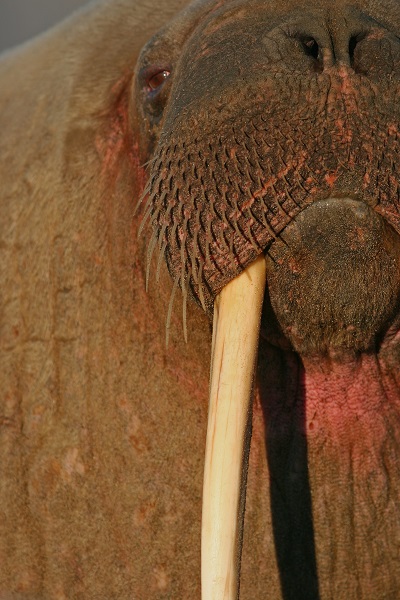
Walrus © F. Ugarte
Canada
In Canada, walrus hunts are comanaged by Fisheries and Oceans Canada (DFO), the Nunavut Wildlife Management Board (NWMB), the Nunavik Marine Regional Wildlife Board (NMRWB), regional wildlife organisations, and local hunters and trappers organisations according to the Fisheries Act and the Nunavut Agreement.
The first regulations on walrus hunting were introduced in 1928 and have been amended several times since then (Wiig et al. 2014). Community quotas were enacted under the Walrus Protection Regulations of 1980, as was the limit of four walrus per year per Inuk. In 1993, the Walrus Protect Regulations were replaced by the Marine Mammal Regulations of the Fisheries Act, which stipulate that an Inuk or land claims beneficiary may, without a license, hunt for food, social or ceremonial purposes up to four walrus in a year. The Marine Mammal Regulations further stipulate requirements for hunting and established community quota levels for four communities in Nunavut: Arctic Bay, Clyde River, Coral Harbour and Sanikiluaq (DFO 2013b).
Nunavut
Under the Nunavut Land Claims agreement of 1993 the Nunavut Wildlife Management Board (NWMB) was established. The NWMB is a decision-making body within the Nunavut Settlement Area, with advisory authority in the adjacent waters. Ultimate responsibility for wildlife management, however, lies with the governments of Nunavut and Canada, which carry out NWMB decisions, once they are made.
In 1999 the NWMB created a walrus working group, which started developing a walrus management plan for Nunavut. This working group’s members have been studying traditional and scientific knowledge about the walrus, looking at problems with the current management system, and suggesting ways to better manage walrus. This new management plan is still under development, now with two working groups (one for Foxe Basin and one for Baffin Bay–High Arctic) currently drafting an Integrated Fisheries Management Plan (IFMP) for walrus in Nunavut (DFO 2013b).
A small number of Nunavut communities (4 of 25) have annual quotas in place; in those that do not, regulations stipulate that individual Inuit may take up to four walrus annually. Inuit hunt statistics are reported by hunters to local hunters and trappers organisations and then relayed to DFO, while sport hunters are required as part of the licensing process to provide information to DFO directly. Annual hunt statistics are not available for a large number of communities, which poses a challenge for effective management (NAMMCO 2018).
Sport hunts
Some communities allow limited sports hunts in which a number of the walrus allotted to communities or individuals are transferred to non-Inuit hunters. Sport hunts for walrus began in Nunavut in 1995 and in Salluit (Nunavik) in 1996. Sport hunts are regulated by the annual issuing of licences, and hunts must be approved by the NWMB (Wiig et al. 2014). Sport hunts have been conducted in Cape Dorset, Hall Beach, Igloolik and Coral Harbour, with only a few walrus taken (DFO 2013b). During the 2012 walrus sport hunt season a total of 18 licences were issued but only 4 walrus were taken (DFO 2012). In Igloolik, sport hunts were suspended for two years, starting in 2008, over community concern that walrus were being disturbed (DFO 2013b).
Russia
In Russian territory, regulations curtailing walrus hunt were introduced in 1921. In 1956 hunting of the Atlantic walrus was prohibited for all Soviet citizens, excluding a limited subsistence hunt by aboriginal people (Wiig et al. 2014).
In 1971, the Novaya Zemlya population of walrus was included in the list of Rare Animals of the USSR. In 1975 regulations for protecting and hunting of marine mammals prohibited sport hunting of walrus as well as any landing on or the littering of shore haul-outs at any time. It also prohibited the possession, manufacture, buying, selling, storage, and transportation of hides and tusks from walrus (Wiig et al. 2014).
Status according to other organisations
The walrus is listed in Appendix III of the Convention on International Trade in Endangered Species of Fauna and Flora (CITES). Appendix III concerns species which are not necessarily endangered, but which are managed by the listing nation. For walrus, the listing nation was Canada. A permit is required for any international trade in walrus parts.
On the IUCN “Red list” the walrus is listed as Data Deficient in an assessment made in 2008 (Lowry et al. 2008).
Utilisation
Walrus have long been a staple food resource for indigenous peoples throughout the Arctic and continue to be an important part of northern diets today. Historically and currently, all parts of the walrus are used for food or other purposes. Walrus tusks remain a valuable commodity and are used to make carvings and jewellery for sale or are sold in their raw form. Ivory carvings made from walrus tusk are an important source of income for some communities. The thick, strong hide of the walrus is used to make traditional footwear and strong, flexible rope for use as harpoon lines.
Walrus meat is a particularly important winter food for Inuit because it can be procured in large amounts in the late summer and fall, and because it can be preserved and stored for long periods of time. Igunaq, or aged, preserved walrus meat, is considered a delicacy in parts of Greenland and Nunavut. To make igunaq, the walrus is flensed so that the skeleton is removed, leaving the skin, fat, meat and some organs in one thick sheet. This sheet is cut into smaller pieces and sewn into large sausage-shaped rolls, called ungirlak. The ungirlak are buried in gravel and left for several months to age and ferment. Experienced hunters know how to choose exactly the right type of gravel for burial, as it must be porous enough to allow some air circulation, as well as to allow the hunter to dig up the bundles during the winter when the ground is frozen. Once dug up, the ungirlak are cut and washed. Igunak is considered such a delicacy that it is often saved for special occasions and feasts, as well as traded to other communities that do not have access to walrus (Tigullaraq 2008).
Hunting
In 2004, NAMMCO hosted a Workshop on Hunting Methods for Seals and Walrus, the report of which provides a wealth of information on walrus hunting techniques. The NAMMCO Workshop on Struck and Lost held in 2006 also provides additional information relevant to this topic.
In Greenland it is currently illegal to hunt walrus on land but legal to hunt them in the water and when hauled out on ice.
Several methods are used to hunt walrus in Canada and Greenland, depending on the season, the ice conditions, and the size of the vessel that is used in open water. A favoured method used in the spring and summer is to hunt walrus that are hauled out on ice pans. The hunters approach walrus herds slowly from down-wind so that the animals cannot catch the hunters’ scent. Resting walrus can often be approached very closely in this way. The hunters then shoot the desired number of animals at close range, taking care to fire simultaneously so that the walrus cannot react to the noise. Large calibre rifles are used and the hunter attempts to kill the animal outright so it cannot re-enter the water. If an injured walrus does reach the water, it is harpooned with an attached line and float, because a dead walrus usually sinks rapidly. Once secured, the walrus is killed and retrieved.
Open water
When there is no ice around, walrus can be hunted in open water, although this is more difficult and often less successful than hunting them on the ice. Walrus are harpooned with a line and float to prevent them from sinking before a killing shot is attempted. Walrus are agile and quick in the water, however, and it is often difficult to approach them closely enough for a successful harpoon strike. For this reason, it is often necessary to shoot the walrus to injure it and slow it down so that it can be approached for harpooning. Once killed, the walrus is towed to shore or to an ice flow for processing or brought on board if hunting from a larger vessel.
Walrus are also taken from the floe edge or as they breathe in holes in thin, young ice during the winter. In such hunts the walrus is first harpooned as it comes up for air, then shot through the head when it returns to breathe. In floe edge hunts, a small boat is used to retrieve the walrus.
Struck-and-lost
As with all marine mammal hunts, struck-and-lost (the failure to retrieve an animal that has been killed or injured by the hunter) is an issue in walrus hunts. The problem is exacerbated because walrus generally sink when killed. Struck-and-lost rates for walrus hunts vary widely, depending on the type of hunt, environmental conditions, and hunter experience among other factors, but have been estimated to average from 32–42% in Canadian, Alaskan and Greenlandic hunts (Orr et al. 1986, Fay et al. 1994). The NAMMCO Workshop on Struck and Lost provided a wealth of information on this topic as well as recommendations to facilitate monitoring and reduce the incidence of struck-and-lost in all types of marine mammal hunts.
Catches in NAMMCO member countries since 1992
| Country | Species (common name) | Species (scientific name) | Year or Season | Area or Stock | Catch Total | Quota (if applicable) |
|---|---|---|---|---|---|---|
| Greenland | Atlantic walrus | Odobenus rosmarus | 2023 | Baffin Bay | 158 | 79 |
| Greenland | Atlantic walrus | Odobenus rosmarus | 2023 | West Greenland-Southeast Baffin Bay (WGSBI) | 119 | 74 |
| Greenland | Atlantic walrus | Odobenus rosmarus | 2023 | East Greenland | 28 | 17 |
| Greenland | Atlantic walrus | Odobenus rosmarus | 2022 | Baffin Bay | 55 | 158 |
| Greenland | Atlantic walrus | Odobenus rosmarus | 2022 | West Greenland-Southeast Baffin Bay (WGSBI) | 63 | 109 |
| Greenland | Atlantic walrus | Odobenus rosmarus | 2022 | East Greenland | 6 | 34 |
| Greenland | Atlantic walrus | Odobenus rosmarus | 2021 | Baffin Bay | 48 | 158 |
| Greenland | Atlantic walrus | Odobenus rosmarus | 2021 | West Greenland | 67 | 102 |
| Greenland | Atlantic walrus | Odobenus rosmarus | 2021 | East Greenland | 12 | 34 |
| Greenland | Atlantic walrus | Odobenus rosmarus | 2020 | East Greenland | 8 | 36 |
| Greenland | Atlantic walrus | Odobenus rosmarus | 2020 | Baffin Bay | 21 | 164 |
| Greenland | Atlantic walrus | Odobenus rosmarus | 2020 | West Greenland-Southeast Baffin Bay | 75 | 103 |
| Greenland | Atlantic walrus | Odobenus rosmarus | 2020 | Total | 104 | 303 |
| Greenland | Atlantic walrus | Odobenus rosmarus | 2019 | East | 7 | 18 |
| Greenland | Atlantic walrus | Odobenus rosmarus | 2019 | Northwater | 46 | 85 |
| Greenland | Atlantic walrus | Odobenus rosmarus | 2019 | West | 61 | 69 |
| Greenland | Atlantic walrus | Odobenus rosmarus | 2019 | Total | 114 | 172 |
| Greenland | Atlantic walrus | Odobenus rosmarus | 2018 | East | 10 | 18 |
| Greenland | Atlantic walrus | Odobenus rosmarus | 2018 | Northwater | 34 | 85 |
| Greenland | Atlantic walrus | Odobenus rosmarus | 2018 | West | 54 | 69 |
| Greenland | Atlantic walrus | Odobenus rosmarus | 2018 | Total | 98 | 172 |
| Greenland | Atlantic walrus | Odobenus rosmarus | 2017 | East | 3 | 18 |
| Greenland | Atlantic walrus | Odobenus rosmarus | 2017 | Northwater | 73 | 85 |
| Greenland | Atlantic walrus | Odobenus rosmarus | 2017 | West | 35 | 69 |
| Greenland | Atlantic walrus | Odobenus rosmarus | 2017 | Total | 111 | 172 |
| Greenland | Atlantic walrus | Odobenus rosmarus | 2016 | East | 9 | 18 |
| Greenland | Atlantic walrus | Odobenus rosmarus | 2016 | Northwater | 74 | 86 |
| Greenland | Atlantic walrus | Odobenus rosmarus | 2016 | West | 52 | 69 |
| Greenland | Atlantic walrus | Odobenus rosmarus | 2016 | Total | 135 | 173 |
| Greenland | Atlantic walrus | Odobenus rosmarus | 2015 | East | 4 | 18 |
| Greenland | Atlantic walrus | Odobenus rosmarus | 2015 | Northwater | 74 | 83 |
| Greenland | Atlantic walrus | Odobenus rosmarus | 2015 | West | 53 | 69 |
| Greenland | Atlantic walrus | Odobenus rosmarus | 2015 | Total | 131 | 170 |
| Greenland | Atlantic walrus | Odobenus rosmarus | 2014 | East | 8 | 18 |
| Greenland | Atlantic walrus | Odobenus rosmarus | 2014 | Northwater | 67 | 61 |
| Greenland | Atlantic walrus | Odobenus rosmarus | 2014 | West | 52 | 61 |
| Greenland | Atlantic walrus | Odobenus rosmarus | 2014 | Total | 127 | 140 |
| Greenland | Atlantic walrus | Odobenus rosmarus | 2013 | East | 8 | 18 |
| Greenland | Atlantic walrus | Odobenus rosmarus | 2013 | Northwater | 65 | 62 |
| Greenland | Atlantic walrus | Odobenus rosmarus | 2013 | West | 47 | 60 |
| Greenland | Atlantic walrus | Odobenus rosmarus | 2013 | Total | 120 | 140 |
| Greenland | Atlantic walrus | Odobenus rosmarus | 2012 | East | 4 | 18 |
| Greenland | Atlantic walrus | Odobenus rosmarus | 2012 | Northwater | 76 | 64 |
| Greenland | Atlantic walrus | Odobenus rosmarus | 2012 | West | 34 | 59 |
| Greenland | Atlantic walrus | Odobenus rosmarus | 2012 | Total | 114 | 141 |
| Greenland | Atlantic walrus | Odobenus rosmarus | 2011 | East | 5 | 18 |
| Greenland | Atlantic walrus | Odobenus rosmarus | 2011 | Northwater | 42 | 52 |
| Greenland | Atlantic walrus | Odobenus rosmarus | 2011 | West | 50 | 60 |
| Greenland | Atlantic walrus | Odobenus rosmarus | 2011 | Total | 97 | 130 |
| Greenland | Atlantic walrus | Odobenus rosmarus | 2010 | East | 7 | 18 |
| Greenland | Atlantic walrus | Odobenus rosmarus | 2010 | Northwater | 60 | 48 |
| Greenland | Atlantic walrus | Odobenus rosmarus | 2010 | West | 40 | 60 |
| Greenland | Atlantic walrus | Odobenus rosmarus | 2010 | Total | 107 | 126 |
| Greenland | Atlantic walrus | Odobenus rosmarus | 2009 | East | 4 | 23 |
| Greenland | Atlantic walrus | Odobenus rosmarus | 2009 | Northwater | 90 | 73 |
| Greenland | Atlantic walrus | Odobenus rosmarus | 2009 | West | 33 | 38 |
| Greenland | Atlantic walrus | Odobenus rosmarus | 2009 | Total | 127 | 134 |
| Greenland | Atlantic walrus | Odobenus rosmarus | 2008 | East | 9 | 30 |
| Greenland | Atlantic walrus | Odobenus rosmarus | 2008 | Northwater | 66 | 80 |
| Greenland | Atlantic walrus | Odobenus rosmarus | 2008 | West | 28 | 65 |
| Greenland | Atlantic walrus | Odobenus rosmarus | 2008 | Total | 103 | 175 |
| Greenland | Atlantic walrus | Odobenus rosmarus | 2007 | East | 10 | 30 |
| Greenland | Atlantic walrus | Odobenus rosmarus | 2007 | Northwater | 80 | 90 |
| Greenland | Atlantic walrus | Odobenus rosmarus | 2007 | West | 43 | 80 |
| Greenland | Atlantic walrus | Odobenus rosmarus | 2007 | Total | 133 | 200 |
| Greenland | Atlantic walrus | Odobenus rosmarus | 2006 | East | 5 | 15 |
| Greenland | Atlantic walrus | Odobenus rosmarus | 2006 | Northwater | 67 | 60 |
| Greenland | Atlantic walrus | Odobenus rosmarus | 2006 | West | 73 | 0 |
| Greenland | Atlantic walrus | Odobenus rosmarus | 2006 | Total | 145 | 75 |
| Greenland | Atlantic walrus | Odobenus rosmarus | 2005 | East | 16 | No quota |
| Greenland | Atlantic walrus | Odobenus rosmarus | 2005 | Northwater | 79 | No quota |
| Greenland | Atlantic walrus | Odobenus rosmarus | 2005 | West | 158 | No quota |
| Greenland | Atlantic walrus | Odobenus rosmarus | 2005 | Total | 253 | No quota |
| Greenland | Atlantic walrus | Odobenus rosmarus | 2004 | East | 4 | No quota |
| Greenland | Atlantic walrus | Odobenus rosmarus | 2004 | Northwater | 88 | No quota |
| Greenland | Atlantic walrus | Odobenus rosmarus | 2004 | West | 102 | No quota |
| Greenland | Atlantic walrus | Odobenus rosmarus | 2004 | Total | 194 | No quota |
| Greenland | Atlantic walrus | Odobenus rosmarus | 2003 | East | 11 | No quota |
| Greenland | Atlantic walrus | Odobenus rosmarus | 2003 | Northwater | 156 | No quota |
| Greenland | Atlantic walrus | Odobenus rosmarus | 2003 | West | 130 | No quota |
| Greenland | Atlantic walrus | Odobenus rosmarus | 2003 | Total | 297 | No quota |
| Greenland | Atlantic walrus | Odobenus rosmarus | 2002 | East | 34 | No quota |
| Greenland | Atlantic walrus | Odobenus rosmarus | 2002 | Northwater | 147 | No quota |
| Greenland | Atlantic walrus | Odobenus rosmarus | 2002 | West | 150 | No quota |
| Greenland | Atlantic walrus | Odobenus rosmarus | 2002 | Total | 331 | No quota |
| Greenland | Atlantic walrus | Odobenus rosmarus | 2001 | East | 8 | No quota |
| Greenland | Atlantic walrus | Odobenus rosmarus | 2001 | Northwater | 95 | No quota |
| Greenland | Atlantic walrus | Odobenus rosmarus | 2001 | West | 116 | No quota |
| Greenland | Atlantic walrus | Odobenus rosmarus | 2001 | Total | 219 | No quota |
| Greenland | Atlantic walrus | Odobenus rosmarus | 2000 | East | 7 | No quota |
| Greenland | Atlantic walrus | Odobenus rosmarus | 2000 | Northwater | 126 | No quota |
| Greenland | Atlantic walrus | Odobenus rosmarus | 2000 | West | 196 | No quota |
| Greenland | Atlantic walrus | Odobenus rosmarus | 2000 | Total | 329 | No quota |
| Greenland | Atlantic walrus | Odobenus rosmarus | 1999 | Total | 325 | No quota |
| Greenland | Atlantic walrus | Odobenus rosmarus | 1998 | Total | 610 | No quota |
| Greenland | Atlantic walrus | Odobenus rosmarus | 1997 | Total | 317 | No quota |
| Greenland | Atlantic walrus | Odobenus rosmarus | 1996 | Total | 305 | No quota |
| Greenland | Atlantic walrus | Odobenus rosmarus | 1995 | Total | 403 | No quota |
| Greenland | Atlantic walrus | Odobenus rosmarus | 1994 | Total | 484 | No quota |
This database of reported catches is searchable, meaning you can filter the information, e.g. by country, species or area. It is also possible to sort it by the different columns, in ascending or descending order, by clicking the column you want to sort by and the associated arrows for the order. By default, 10 entries are shown, but this can be changed in the drop-down menu, where you can decide to show up to 100 entries per page.
Carry-over from previous years are included in the quota numbers, where applicable.
You can find the full catch database with all species here.
For any questions regarding the catch database, please contact the Secretariat at nammco-sec@nammco.no.
While over-hunting was the primary cause of decline in walrus numbers during the 20th century, other human activities can also have an impact on walrus populations.
Disturbances
Walrus are very sensitive to human-caused environmental disturbances, such as the noise of boats and low-flying airplanes. Noise from increased industrial activity in the Arctic, such as seismic surveys, exploration drilling, building of production facilities and other traffic related disturbances linked to oil exploration activities, including helicopter transport and intensified shipping, may potentially displace walrus from their wintering grounds or other important feeding grounds (Dietz et al. 2014). It can mask communications, result in impaired thermoregulation and increased stress levels, and cause stampedes at haulout sites. Hauled out walrus disturbed by noise may panic and flee, which can sometimes lead to the death of animals, especially calves, by trampling. Walrus that are disturbed or displaced from an area tend not to return. Repeated disturbance may cause walrus to abandon an uglit, or haulout site, forever.
In the Arctic, walrus are likely to be exposed to greatly increased shipping associated with both reduced sea ice and increased exploration and extraction of minerals and hydrocarbons (DFO 2013b). There are large and expanding non-renewable resource exploration and development in Baffin Island, Northern Greenland, Barents and Pechora Seas and Southwest Kara Sea (e.g., Semyonova et al 2015, Higdon and Stewart 2018).
The increase of commercial shipping and low altitude flying related to industrial development with routes running through core habitat (e.g., Foxe Basin, Hudson Strait, Baffin Bay, West Greenland) represent a threat to several of the populations (e.g., COSEWIC 2017, NAMMCO 2018). Offshore sand mining is also of concern as it both bring disturbance to the walrus but also to their main prey, the bivalves.
Direct conflicts with fisheries are uncommon, with occasional interactions with trawl and longline gear of groundfish fisheries considered as insignificant (USFW 2017, COSEWIC 2017), and that in all areas. However, trawl fisheries could disturb important benthic feeding areas, although the extent of this impact off western Greenland is not known (NAMMCO 2013, COSEWIC 2017). In Svalbard, increasing tourism is being monitored to ensure that it does not affect walrus distribution or behaviour.
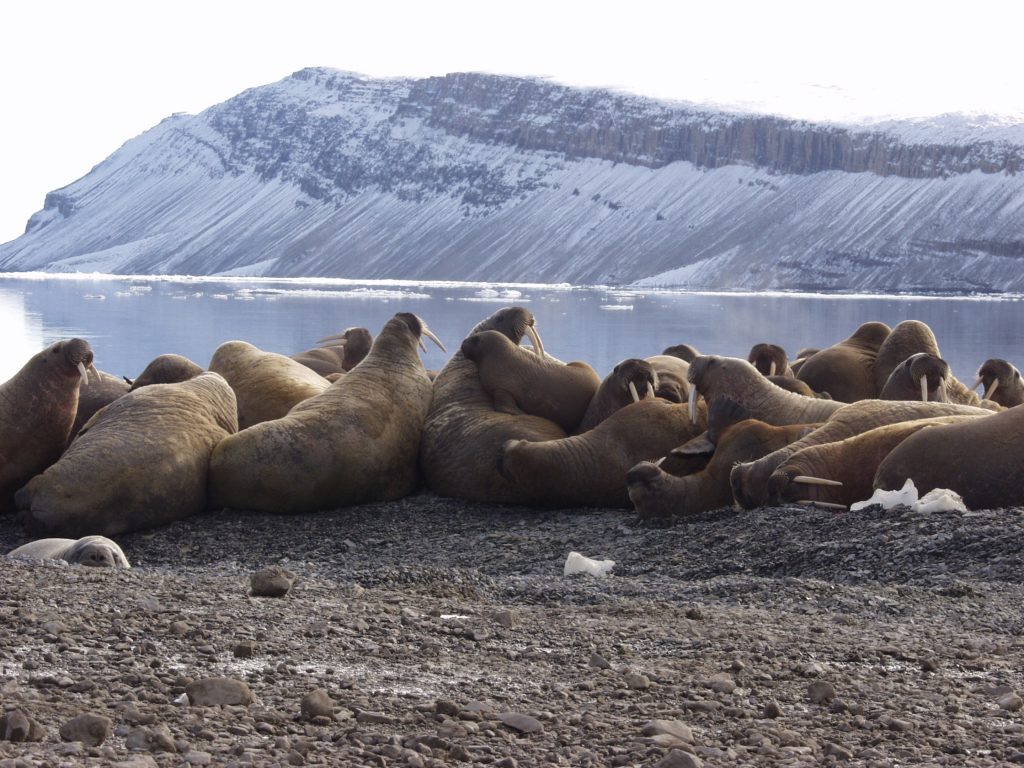
© R. Stewart
Pollution
Another potential threat to walrus populations is pollution from oil and gas exploration and extraction activities. Walrus are particularly at risk from oil spills as their staple diet items of benthic invertebrates are known to accumulate hydrocarbons (Born et al. 1995). Other pollutants of concern are heavy metals, such as cadmium, lead and mercury. Elevated levels of these metals have been found in Atlantic walrus tissues, though it is not clear what effect these might have on walrus health (Born et al. 1995). Relatively high levels of organochlorines such as DDT and PCBs have also been found in walrus that eat seals, although in a fairly recent study in Svalbard, levels of these compounds were found to be substantially lower than those of animals sampled in the same area 10 years earlier (Wolkers et al. 2006). A surprising result from the same study was that individual variation in contaminant levels and patterns was very high, even though the walrus sampled were from a homogenous group that consisted solely of adult males from a restricted geographic area (Wolkers et al. 2006).
In the Barents Sea, contaminant burdens have been confirmed high and of concern, with confirmed altered thyroid and immune function (Routti et al. 2019), though other assessment of their health remain normal (Scotter et al. 2019).
Habitat & climate changes
Walrus are quite conservative in their choice of habitat and food, so any reduction in either of these may have detrimental effects on their numbers. Walrus numbers could be threatened by a loss of sea ice caused by global warming and accompanying environmental changes, with retreating sea ice reducing the availability of suitable habitat and food supply and affecting walrus movement and behaviour (Dietz et al. 2014). Changes in sea ice extent and location could also affect human hunting patterns, providing hunters easier access to walrus.
The direct impact of ice and climate dynamics on bivalves and other ecosystem components which in turn will affect walrus needs to be identified. Sea ice losses induced by global warming remained of serious concern as they may displace walrus towards land haulouts, away from food resources, thus generating increased energy expenditures to reach prey resources. The effect of ocean acidification on walrus prey is another issue of concern because lower pH levels can interfere with invertebrate shell formation and erode existing shells, although it is not known which prey species will be able to adapt or whether walrus can switch to other prey species (e.g., USFW 2017). Although walrus may experience skin damage due to UV exposure, a relation between the increased sun radiation secondary to ozone loss and walrus health has not been reported at this point (Martinez-Levasseur et al 2016). Disease risk for this gregarious pinniped is an increasing concern in a warming Arctic (Van Wormer et al. 2019).
Several walrus stocks are already facing simultaneously the impacts of sea ice losses and industrial development combined with hunt, there is a need for joint research on the cumulative effects of multiple stressors on populations of concern. There is also a need for careful management, taking into account the rapid industrial development in the Arctic, and for joint-assessment and management regime for shared stocks.
Research in NAMMCO Member Countries
Greenland
Research on walrus populations in Greenland is ongoing, focusing on stock identification, walrus behaviour and population trends, with as prominent actor, the Greenland Institute of Natural Resources.
Regular aerial surveys are conducted off West Greenland and in the North Water Polynya the latest in 2018 (National Progress Report Greenland 2018, 2019). Analysis of the 2018 survey was finalised for the 2018 meeting of the NAMMCO Working Group on Walrus.
A new terrestrial haulout location was established in Qaanaaq in 2018. An automated camera was placed here in 2021 to monitor the haulout (National Progress Report Greenland 2020).
Norway
Research on the walrus population on Svalbard is ongoing. Future plans include aerial surveys at 5-year intervals of the Svalbard fraction of the Svalbard-Franz Josef Land population to monitor abundance trends. A synoptic aerial survey of the whole population, including the Russian territories, has high priority and has been planned, but not yet conducted. Prominent in these research efforts has been the Norwegian Polar Institute. The latest aerial survey flown in Svalbard was in August 2018 (National Progress Report Norway 2018).
Possible future dietary shifts, due to climate change induced changes in the marine ecosystem is assessed via analysis of walrus tissue for stable isotopes and fatty acids at regular intervals. Walrus are also tracked over multiple years using tusk-mounted GPS loggers in order to study individual responses to changes in ice conditions. 20 animals were equipped with loggers both in 2014 and 2015. The battery life on these loggers should be a minimum of 5 years and data has last been collected from receiving stations in the summer of 2020. This project is mainly funded by the Norwegian-Russian Environmental Commission (National Progress Report Norway 2020).
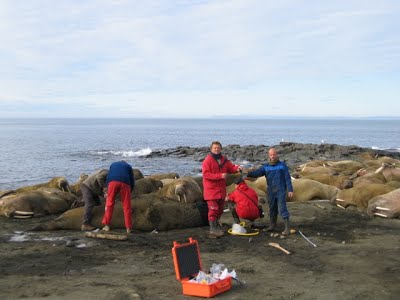
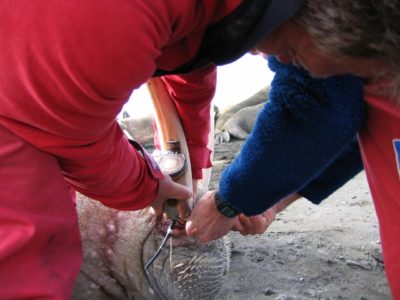
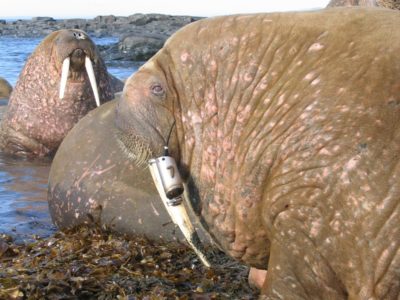
Monitoring and genetic sampling
Walrus haulout sites are being long-term monitored by digital camera during the period late June- early October to study haulout behaviour and the potential impact of visiting tourists to these sites. It is hoped to obtain long enough time trends and large enough sample sizes to effectively monitor the status of the population.
Studies are also investigating level and trends of pollutants and the stock structure of Svalbard walrus. Currently, the genetic relationship between walrus in the Pechora and Kara Seas and those in the Svalbard-Franz Josef Land area is unknown.
Andersen, L.W., Born, E. W., Stewart, R.E.A., et al. (2014). A genetic comparison of West Greenland and Baffin Island (Canada) walruses: Management implications. NAMMCO Scientific Publications, 9, 33–52. http://dx.doi.org/10.7557/3.2610
Andersen, L.W., Jacobsen, M.W., Lydersen, C. al. 2017. Walruses (Odobenus rosmarus rosmarus) in the Pechora Sea in the context of contemporary population structure of Northeast Atlantic walruses. Biological Journal of the Linnean Society, 122, 897–915.
Belikov S.E. (2018). Sea mammals of the Russian Arctic: changes of number and environment influenced by anthropogenic and natural factors. Marine Mammals of the Holarctic, 1, 2055251
Born, E. W. and Gjertz, I. (1993). A link between walruses (Odobenus rosmarus) in northeast Greenland and Svalbard. Polar Record, 29(71), 329. http://dx.doi.org/10.1017/S0032247400023986
Born, E.W., Rysgaard, S., Ehlme, G., et al. (2003). Underwater observations of foraging free-living Atlantic walruses (Odobenus rosmarus rosmarus) and estimates of their food consumption. Polar Biology, 26, 348–357. https://doi.org/10.1007/s00300-003-0486-z
Born, E.W., Gjertz, I. and Reeves, R.R. (1995). Population assessment of the Atlantic walrus (Odobenus rosmarus rosmarus L.). Norsk Polarinstitutt Meddelelser, 138, pp. 100.
Born, E. (2011). Walrus Odobenus rosmarus. In D. Boertmann and A. Mosbech (eds.), The Western Greenland Sea: A Strategic Environmental Impact Assessment of Hydrocarbon Activities, 114–125. Danish Centre for Environment and Energy. Scientific Report from DCE—Danish Centre for Environment and Energy No. 22. https://www2.dmu.dk/Pub/SR22.pdf
Born, E. (2017) Walrus Odobenus rosmarus. In D. Boertmann and A. Mosbech (eds.), Baffin Bay: An Updated Strategic Environmental Impact Assessment of Petroleum Activities in the Greenland Part of Baffin Bay, 127–137, Chapter 4.8.2. Danish Centre for Environment and Energy. Scientific Report from DCE—Danish Centre for Environment and Energy No. 218. http://dce2.au.dk/pub/SR218.pdf
Citta, J.J., Lowry, L.F., Quakenbush, L.T. et al. (2018). A multi-species synthesis of satellite telemetry data in the Pacific Arctic (1987–2015): Overlap of marine mammal distributions and core use areas. Deep Sea Research Part II: Topical Studies in Oceanography, 152, 132–153. https://doi.org/10.1016/j.dsr2.2018.02.006
COSEWIC. (2017). COSEWIC assessment and status report on the Atlantic Walrus Odobenus rosmarus rosmarus, High Arctic population, Central-Low Arctic population and Nova Scotia-Newfoundland-Gulf of St. Lawrence population in Canada. Committee on the Status of Endangered Wildlife in Canada. Ottawa. xxi + 89 pp. Available at: https://wildlife-species.canada.ca/species-risk-registry/virtual_sara/files/cosewic/sr_Atlantic%20Walrus_2017_e.pdf
Crawford, J.A., Quakenbush, L.T., Citta, J.J., et al. (2016). Using movement, diving and haul out behavior to identify the relative importance of foraging areas for walruses in the Alaskan Chukchi Sea. Alaska Marine Science Symposium, 25-29 January, Anchorage, AK.
Dietz, R., Born, E. W., Stewart, R. E. A., et al. (2014). Movements of walruses (Odobenus rosmarus) between Central West Greenland and Southeast Baffin Island, 2005–2008. NAMMCO Scientific Publications, 9, 53–74. http://dx.doi.org/10.7557/3.2605
DFO. (2016a). Estimating abundance and total allowable removals for walrus in the Hudson Bay-Davis Strait and south and east Hudson Bay stocks during September 2014. DFO Can Sci Advis Sec Res Doc 2016/036. v + 37 p
DFO. (2016b). Estimating abundance and total allowable removals for walrus in Foxe Basin. DFO Canadian Scientific Advisory Secretariat. Res Doc 2016/014. iv + 20 p.
DFO. (2013a). Estimates of Abundance and Total Allowable Removals for Atlantic Walrus (Odobenus rosmarus rosmarus) in the Canadian Arctic. DFO Canadian Science Advisory Secretariat. Sci. Advis. Rep. 2013/034. http://www.dfo-mpo.gc.ca/csas-sccs/Publications/SAR-AS/2013/2013_034-eng.html
DFO. (2013b). Proceedings of the Pre-COSEWIC Peer Review Meeting for Atlantic walrus (Odobenus rosmarus rosmarus) (2012, February 28–March 1). DFO Canadian Science Advisory Secretariat. Proceed. Ser. 2012/041. Available at: http://www.dfo-mpo.gc.ca/csas-sccs/Publications/Pro-Cr/2012/2012_041-eng.html
DFO. (2012). DFO submission to the NWMB (October). Available at http://www.nwmb.com
Fay, F.H., Burns, J.J., Stoker, S.W. and Grundy, J.S. (1994). The Struck-and-Lost Factor in Alaskan Walrus Harvests, 1952-1972. Arctic, 47(4), 368–373. https://doi.org/10.14430/arctic1310
Freitas, C., Kovacs, K.M., Ims, R.A., Fedak, M.A. and Lydersen, C. (2009). Deep into the ice: overwintering and habitat selection in Atlantic walruses. Marine Ecology Progress Series, 375, 247–261. https://doi.org/10.3354/meps07725
Glazov, D. M., Shpak, O. V., Kuznetsova, D. M. et al. (2013). Observations of the Walrus (Odobenus rosmarus) in the Barents, Kara, and Laptev Seas in 2010–2012. Biology Bulletin, 40, 783-789. https://doi.org/10.1134/S1062359013090057
Heide-Jørgensen, M.P., Flora, J., Andersen, A.O., Stewart, R.E.A., Nielsen, N.H. and Hansen, R.G (2017). Walrus Movements in Smith Sound: A Canada-Greenland Shared Stock. Arctic, 70(3), 308–318. https://doi.org/10.14430/arctic4661
Heide-Jørgensen, M. P., Sinding, M.S., Nielsen, N.H., Rosing-Asvid, A. and Hansen, R.G. (2016). Large numbers of marine mammals winter in the North Water polynya. Polar Biology, 39, 1605–1614. https://doi.org/10.1007/s00300-015-1885-7
Heide-Jørgensen, M.P., Laidre, K.L., Fossette, S. et al. (2013). Abundance of walruses in Eastern Baffin Bay and Davis Strait. NAMMCO Scientific Publications, 9, 159–171. http://dx.doi.org/10.7557/3.2606
Heide-Jørgensen, M. P., Burt, L.M., Hansen, R.G. et al. (2012). The significance of the North Water polyna to Arctic top predators. AMBIO, 42, 596–610. https://doi.org/10.1007/s13280-012-0357-3
Higdon, J.W. and Stewart, D.B. (2018). State of circumpolar walrus (Odobenus rosmarus) populations. Prepared by Higdon Wildlife Consulting and Arctic Biological Consultants, Winnipeg, MB for WWF Arctic Programme, Ottawa, ON. 100 pp.
Kovacs, K.M. (2016). Odobenus rosmarus ssp. rosmarus. The IUCN Red List of Threatened Species 2016: e.T15108A66992323. https://dx.doi.org/10.2305/IUCN.UK.2016-1.RLTS.T15108A66992323.en
Kovacs, K.M., Aars, J. and Lydersen, C. (2014). Walruses recovering after 60+ years of protection in Svalbard, Norway. Polar Research, 33. https://doi.org/10.3402/polar.v33.26034
Lindqvist, C., Bachmann, L., Andersen, L.W. et al. (2008). The Laptev Sea walrus Odobenus rosmarus laptevi: an enigma revisited. Zoologica Scripta, 38, 113–127. https://doi.org/10.1111/j.1463-6409.2008.00364.x
Lowry, L. (2016). Odobenus rosmarus. The IUCN Red List of Threatened Species 2016: e.T15106A45228501. Available at: http://www.iucnredlist.org/details/15106/0
Lydersen, C. and Kovacs, K. (2014). Walrus Odobenus rosmarus research in Svalbard, Norway, 2000- 2010. NAMMCO Scientific Publications, 9, 175-190. http://dx.doi.org/10.7557/3.2613
Lydersen, C., Chernook, V., Glazov, D. et al. (2012). Aerial survey of Atlantic walruses (Odobenus rosmarus rosmarus) in the Pechora Sea, August 2011. Polar Biology, 35, 1555-1562. https://doi.org/10.1007/s00300-012-1195-2
Lydersen, C., Aars, J. and Kovacs, K. M. (2008). Estimating the number of walruses in Svalbard from aerial surveys and behavioural data from satellite telemetry. Arctic, 61, 119-128. https://doi.org/10.14430/arctic31
Lydersen, C., Lindgren, Å., Alfredsson, K., Kovacs, K. (2022). A Walrus (Odobenus rosmarus) at the North Pole. Aquatic Mammals, 48(6), 513-516, https://doi.org/10.1578/AM.48.6.2022.513.
Martinez-Levasseur, L.M., Furgal, C.M., Hammill, M.O., and Burness, G. (2016). Towards a better understanding of the effects of UV on Atlantic walruses, Odobenus rosmarus rosmarus: a study combining histological data with local ecological knowledge. PLoS ONE, 11(4): e0152122. https://doi.org/10.1371/journal.pone.0152122
Miljøovervåking Svalbard og Jan Mayen (MOSJ). (2019). Hvalross (Odobenus marinus). http://www.mosj.no/no/fauna/hav/hvalross-bestand.html
North Atlantic Marine Mammal Commission (NAMMCO). (2018). Report of the NAMMCO Scientific Working Group on Walrus, October 2018. North Atlantic Marine Mammal Commission, Tromsø, Norway. https://nammco.no/topics/annual-report-2018/
North Atlantic Marine Mammal Commission (NAMMCO). (2015). NAMMCO Annual Report 2015. NAMMCO, Tromsø, Norway. https://nammco.no/topics/annual-reports/
North Atlantic Marine Mammal Commission (NAMMCO). (2013a). NAMMCO Annual Report 2013. NAMMCO, Tromsø, Norway, pp. 305. https://nammco.no/topics/annual-reports/
North Atlantic Marine Mammal Commission (NAMMCO). (2013b). Report of the 20th Meeting of the Scientific Committee, Reykjavík, Iceland. https://nammco.no/topics/scientific-committee-reports/
Orr, J.R., Renooy, B. and Dahke, L. (1986). Information from hunts and surveys of walrus (Odobenus rosmarus) in northern Foxe Basin, Northwest Territories, 1982-1984. Canadian Manuscript Report of Fisheries and Aquatic Sciences 1899, vi +24 p.
Outridge, P.M. and Stewart, R.E.A. (1999). Stock discrimination of Atlantic walrus (Odobenus rosmarus rosmarus) in the eastern Canadian Arctic using lead isotope and element signatures in teeth. Canadian Journal of Fisheries and Aquatic Sciences, 56, 105-112. https://doi.org/10.1139/f98-155
Outridge, P.M., Davis, W.J., Stewart, R.E.A. and Born, E.W. (2003). Investigation of the stock structure of Atlantic walrus (Odobenus rosmarus rosmarus) in Canada and Greenland using dental Pb isotopes derived from local geochemical environments. Arctic, 56, 82-90. https://doi.org/10.14430/arctic605
Routti, H., Diot, B., Panti, C. et al. (2019). Contaminants in Atlantic walruses in Svalbard Part 2: Relationships with endocrine and immune systems. Environmental Pollution, 246, 658–667. https://doi.org/10.1016/j.envpol.2018.11.097
Richard, P. (2001). Marine Mammals of Nunavut. Department of Education, Nunavut, pp. 98.
Salter, R.E. (1979). Observations on social behaviour of Atlantic walruses (Odobenus rosmarus L.) during terrestrial haul-out. Canadian Journal of Zoology, 58, 461-463. https://doi.org/10.1139/z80-061
Scotter, S.E., Tryland, M., Nymo, I.H. et al. (2019). Contaminants in Atlantic walruses in Svalbard part 1: Relationships between exposure, diet and pathogen prevalence. Environmental Pollution, 244, 9–18. https://doi.org/10.1016/j.envpol.2018.10.001
Semyonova, V.S., Boltunov, A.N. and Nikiforov V.V. (2015). Study and conservation of the Atlantic walrus in the southeastern Barents Sea and adjacent areas of the Kara Sea. The results of studies 2011–2014. WWF, Murmansk.
Semyonova, V., Boltunov, A. and Nikiforov, V. (2019). Key habitats and movement pattern of Pechora Sea walruses studied using satellite telemetry. Polar Biology, 42, 1763–1774. https://doi.org/10.1007/s00300-018-02451-7
Shafer, A., Davis, C.S., Coltman, D.W. and Stewart, R.E.A. (2014). Microsatellite assessment of walrus (Odobenus rosmarus rosmarus) stocks in Canada. NAMMCO Scientific Publications, 9, 15–31. http://dx.doi.org/10.7557/3.2607
Sjare, B. and Stirling, I. (1996). The breeding behavior of Atlantic walruses, Odobenus rosmarus rosmarus, in the Canadian High Arctic. Canadian Journal of Zoology, 74(5), 897–911. https://doi.org/10.1139/z96-103
Sjare, B., Stirling, I. and Spencer, C. (2003). Structural variation in the songs of Atlantic walruses breeding in the Canadian High Arctic. Aquatic Mammals, 29, 297–318. https://doi.org/10.1578/016754203101024121
Stewart, R.E.A. (2008). Redefining walrus stocks in Canada. Arctic, 61, 292–308. https://doi.org/10.14430/arctic26
Stewart, R. E. A., Born, E. W., Dunn, J.B., et al. (2014a). Use of multiple methods to estimate walrus (Odobenus rosmarus rosmarus) abundance in the Penny Strait – Lancaster Sound and West Jones Sound Stocks, Canada. NAMMCO Scientific Publications, 9, 95–122. https://doi.org/10.7557/3.2608
Stewart, R. E. A., Born, E.W., Dietz, R. and Ryan, A.K. (2014b). Estimates of Minimum Population Size for Walrus around Southeast Baffin Island, Nunavut. NAMMCO Scientific Publications, 9, 141–157. https://doi.org/10.7557/3.2615
Stewart, R.E.A., Hamilton, J.W. and Dunn, J.B. (2013). Results of Foxe Basin walrus (Odobenus rosmarus rosmarus) surveys: 2010-2011. DFO Canadian Scientific Advisory Secretariat. Res. Doc. 2013/017, iv + 12 p. http://www.dfo-mpo.gc.ca/csas-sccs/Publications/ResDocs-DocRech/2013/2013_017-eng.html
Stirling, I., Calvert, W. and Cleator, H. (1983). Underwater vocalizations as a tool for studying the distribution and abundance of wintering pinnipeds in the High Arctic. Arctic, 36, 262–274. https://doi.org/10.14430/arctic2275
Ugarte, F., Rosing-Asvid, A., Heide-Jørgensen, M.P. and Laidre, K.L. 2020. Marine Mammals of the Greenland Seas. In M.I. Goldstein and D.A. DellaSala (eds.), Encyclopedia of the World’s Biomes 2020, 575-586. https://doi.org/10.1016/B978-0-12-409548-9.12485-6
U.S. Fish and Wildlife Service (USFW). (2017). Final species status assessment for the Pacific walrus (odobenus rosmarus divergens), May 2017 (Version 1.0).
Wiig, Ø., Born, E.W. and Stewart, R.E.A. (2014). Management of Atlantic walrus (Odobenus rosmarus rosmarus) in the arctic Atlantic. NAMMCO Scientific Publications, 9, 315–341. https://doi.org/10.7557/3.2855
Wiig, Ø., Berg, V., Gjertz, I. et al. (2000). Use of skin biopsies for assessing levels of organochlorines in walruses (Odobenus rosmarus). Polar Biology, 23, 272–278. https://doi.org/10.1007/s003000050444
Witting, L. and Born, E.W. (2014). Population dynamics of walrus in Greenland. NAMMCO Scientific Publications, 9, 191–218. https://doi.org/10.7557/3.2612
Witting, L. and Born, E.W. (2005). An assessment of Greenland walrus populations. ICES Journal of Marine Science, 62, 266–284. https://doi.org/10.1016/j.icesjms.2004.11.001
Wolkers, H., van Bavel, B., Ericson, I., et al. (2006). Congener- specific accumulation and patterns of chlorinated and brominated contaminants in adult male walruses from Svalbard, Norway: Indications for individual-specific prey selection. Science of the Total Environment, 370, 70–79. https://doi.org/10.1016/j.scitotenv.2006.06.005




